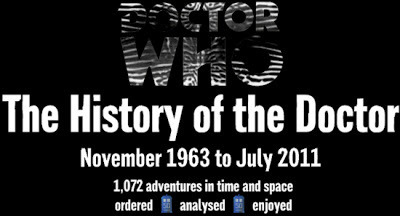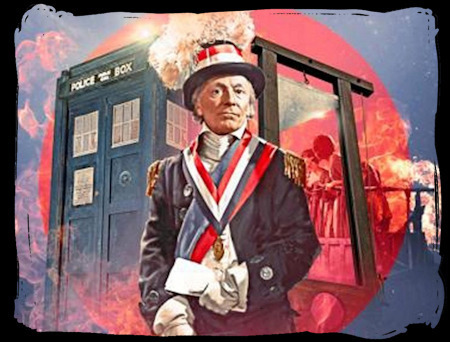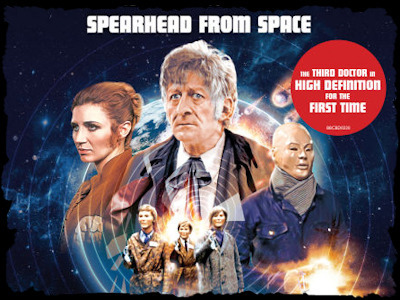E.G. Wolverson's Blog, page 18
September 3, 2013
Book Review | Star Trek: Typhon Pact - Rough Beasts of Empire by David R George III

The third Star Trek: Typhon Pact novel is ostensibly the most alluring of them all, largely due to the promise of its cover, which juxtaposes a surprisingly-clean-shaven and short-haired Benjamin Sisko with an elderly Spock who can’t be far off his silver screen date with a genocidal, time-travelling Romulan. Such a conjunction is not only unique but will be instantly appealing to most readers of the range, which is more than could be said of another heavy political novel grounded on Romulus, which is what this book’s innards actually provide. This makes David R George III’s novel a very difficult one to consider objectively, as it’s almost impossible to look past one’s disappointment at the dearth of any meaningful Spock / Sisko interaction, and, to a lesser extent, the missed opportunity to examine one of the coalition’s lesser-known cultures, such as the lightly-touched-upon Tzenkethi.
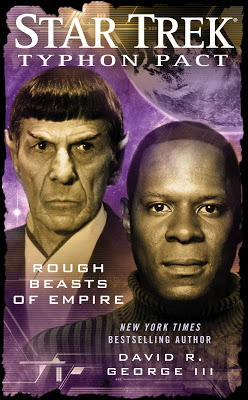 For what it is though, Rough Beasts of Empire is actually very absorbing; perhaps even the finest of the post-finale Romulan-driven novels (of which there are many). Whilst the plot is admittedly slow and character-driven, George handles its twists and turns with remarkable poise, often leaving the reader in the unfamiliar – and thus rather exciting – position of trying to unravel the motives of the novel’s heroes as well as those antagonising them.
For what it is though, Rough Beasts of Empire is actually very absorbing; perhaps even the finest of the post-finale Romulan-driven novels (of which there are many). Whilst the plot is admittedly slow and character-driven, George handles its twists and turns with remarkable poise, often leaving the reader in the unfamiliar – and thus rather exciting – position of trying to unravel the motives of the novel’s heroes as well as those antagonising them.The green-blooded Star Trek legend carries the political aspects of the book dexterously, as an attempt on his life prompts him to opportunistically reconsider his strategy towards reunifying Vulcan and Romulus. Between the events of The Next Generation’s “Unification” episodes and the start of this novel, Spock has done little more continue to preach from the shadows. Here, however, he elects to capitalise upon the recent divide of the Romulan people into two discrete states by manipulating the Star Empire’s praetor into legalising his reunification movement, the idea being that it would serve her ends to reunify the Romulan people, as Romulus couldn’t hope to reunify with Vulcan until it is itself whole again. As events play out, the move reveals a hard edge to the Vulcan that you’ll be hard-pressed to find outside a J J Abrams film, which personally I find fascinating.
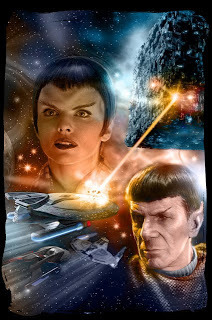 Sisko’s thread of the narrative focuses more on his emotional state than it does incident or agenda, and it’s made even more difficult to follow thanks to the author’s holding back of certain knowledge until the book’s end, not to mention the lost four years that have passed for the captain since the events of The Soul Key. This is made up for though by George finally giving credence to the prophecy that Sisko would “know nothing but sorrow” should he defy the will of the Prophets by marrying Kassidy, which of course made sense when the Deep Space Nine television series’ finale tore the newlyweds apart, but was subsequently rendered meaningless by the captain’s happy return from the Celestial Temple in print. George has such a wonderful handle on Sisko’s gallant, pugnacious spirit that even when he seems to be acting against his character, as he often does here, the portrayal still holds true, and is eventually vindicated in the novel’s culminating, heartbreaking revelation.
Sisko’s thread of the narrative focuses more on his emotional state than it does incident or agenda, and it’s made even more difficult to follow thanks to the author’s holding back of certain knowledge until the book’s end, not to mention the lost four years that have passed for the captain since the events of The Soul Key. This is made up for though by George finally giving credence to the prophecy that Sisko would “know nothing but sorrow” should he defy the will of the Prophets by marrying Kassidy, which of course made sense when the Deep Space Nine television series’ finale tore the newlyweds apart, but was subsequently rendered meaningless by the captain’s happy return from the Celestial Temple in print. George has such a wonderful handle on Sisko’s gallant, pugnacious spirit that even when he seems to be acting against his character, as he often does here, the portrayal still holds true, and is eventually vindicated in the novel’s culminating, heartbreaking revelation.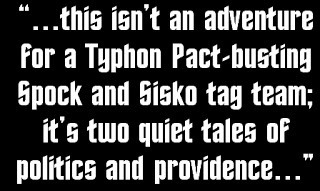 If you’re looking for a slow and insightful read, then they don’t come much better than Rough Beasts of Empire. However, if you saw the cover illustration, caught your reflection and noticed that you were drooling, then be warned – this isn’t an adventure for a Typhon Pact-busting Spock and Sisko tag team; it’s two quiet tales of politics and providence, linked only by their respective effects on the fateful leader of a breakaway nation. Rough Beasts of Empire is currently available in paperback (cheapest price online today is £5.33 from
AbeBooks
) and e-book formats (£4.41 from Amazon’s Kindle Store or £4.49 from
iTunes
).
If you’re looking for a slow and insightful read, then they don’t come much better than Rough Beasts of Empire. However, if you saw the cover illustration, caught your reflection and noticed that you were drooling, then be warned – this isn’t an adventure for a Typhon Pact-busting Spock and Sisko tag team; it’s two quiet tales of politics and providence, linked only by their respective effects on the fateful leader of a breakaway nation. Rough Beasts of Empire is currently available in paperback (cheapest price online today is £5.33 from
AbeBooks
) and e-book formats (£4.41 from Amazon’s Kindle Store or £4.49 from
iTunes
).
Published on September 03, 2013 05:39
September 1, 2013
DVD Review | Doctor Who: Inferno (Special Edition)
Published on September 01, 2013 13:15
August 29, 2013
Blu-ray Review | Star Trek: The Next Generation – Season One
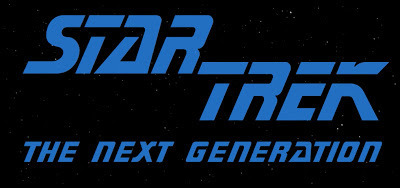 My excitement at the prospect of TNG HD was admittedly tempered by the inexorable fact that the remastered Season 1 would be released first. Whilst the Enterprise-D’s first year was certainly an eventful one, it generated very few classic episodes and more than its fair share of clangers. The belatedness of this review is largely down to the psychological block that I ran into when I knew that “Haven” was up next – almost six months passed before I was able to force myself through it and resume my 1080p mission. Of course, it would be unfair in the extreme to dismiss a season that contains episodes as powerful as “Justice” and “Symbiosis”, or as thrilling as “Conspiracy”, on the strength of its poorest showings, but unfortunately there are far more poor and average episodes here than there are good ones.
My excitement at the prospect of TNG HD was admittedly tempered by the inexorable fact that the remastered Season 1 would be released first. Whilst the Enterprise-D’s first year was certainly an eventful one, it generated very few classic episodes and more than its fair share of clangers. The belatedness of this review is largely down to the psychological block that I ran into when I knew that “Haven” was up next – almost six months passed before I was able to force myself through it and resume my 1080p mission. Of course, it would be unfair in the extreme to dismiss a season that contains episodes as powerful as “Justice” and “Symbiosis”, or as thrilling as “Conspiracy”, on the strength of its poorest showings, but unfortunately there are far more poor and average episodes here than there are good ones.
 It’s quite helpful, then, that the Blu-ray release complements the episodes with not only all the special features originally released on the series’ 2002 DVDs, but also a candid and compelling retrospective ‘making of’ feature that, for ease of digestion, has been divided into three half-hour parts. Stardate Revisited not only offers you an alternative to the unappealing next episode that you can’t bring yourself to face just yet, but an explanation as to why it isn’t all that it perhaps might have been. Whereas the DVD’s Making of a Legend was quite a warm and pleasant feature that told the potted history of the show’s creation, Stardate Revisited is much more honest and revealing. A lot of the blame for the first season’s comparatively poor quality is laid at the door of the late series’ creator, Gene Roddenberry, which could raise a number of Trekkies’ ire despite the picture painted being one of a man passionate about his vision rather than a creative despot working without a net. Many former writers and members of the production team are on hand to discuss the stifling guidelines within which they report being forced to work, with one contributor even pointing out that “...at his best, Gene could take a bad script and turn it into a good one; at his worst, he could take a great script and turn it into a good one”. This is understandable though given the circumstances - with superstar salaries threatening to take most of the profit out of future Star Trek movies, Paramount had set about creating a new Star Trek television series starring relative unknowns, and their early concept work did not meet with Roddenberry’s approval. When he stepped in to take over the project, and was given the freedom that first-run syndication offered, it isn’t surprising that he made that show that only he wanted to make.
It’s quite helpful, then, that the Blu-ray release complements the episodes with not only all the special features originally released on the series’ 2002 DVDs, but also a candid and compelling retrospective ‘making of’ feature that, for ease of digestion, has been divided into three half-hour parts. Stardate Revisited not only offers you an alternative to the unappealing next episode that you can’t bring yourself to face just yet, but an explanation as to why it isn’t all that it perhaps might have been. Whereas the DVD’s Making of a Legend was quite a warm and pleasant feature that told the potted history of the show’s creation, Stardate Revisited is much more honest and revealing. A lot of the blame for the first season’s comparatively poor quality is laid at the door of the late series’ creator, Gene Roddenberry, which could raise a number of Trekkies’ ire despite the picture painted being one of a man passionate about his vision rather than a creative despot working without a net. Many former writers and members of the production team are on hand to discuss the stifling guidelines within which they report being forced to work, with one contributor even pointing out that “...at his best, Gene could take a bad script and turn it into a good one; at his worst, he could take a great script and turn it into a good one”. This is understandable though given the circumstances - with superstar salaries threatening to take most of the profit out of future Star Trek movies, Paramount had set about creating a new Star Trek television series starring relative unknowns, and their early concept work did not meet with Roddenberry’s approval. When he stepped in to take over the project, and was given the freedom that first-run syndication offered, it isn’t surprising that he made that show that only he wanted to make.
 What I found especially interesting about Stardate Revisited weren’t so much the accounts of grievances and revolving doors, but the instances where Roddenberry is said to have given up some ground, and the results of him so doing. Whilst everyone seems to be in agreement that everybody’s favourite ensign, Wesley Crusher, was the brainchild of Roddenberry, and Roddenberry alone, it seems that Bob Justman had to fight long and hard to get a Klingon onto the Enterprise’s bridge. Roddenberry is said to have mooted getting rid of the Enterprise in favour of some other means of conveyance, and had to be gently reminded that, at least at that point, the Starship Enterprise was Star Trek in the audience’s eyes. While Roddenberry tried to cast Stephen Macht as Captain Picard, Justman pushed for Patrick Stewart, and even when Roddenberry agreed to the Englishman’s casting, it was with the stipulation that he must wear a wig. Fortunately Paramount executives thought better of it.
What I found especially interesting about Stardate Revisited weren’t so much the accounts of grievances and revolving doors, but the instances where Roddenberry is said to have given up some ground, and the results of him so doing. Whilst everyone seems to be in agreement that everybody’s favourite ensign, Wesley Crusher, was the brainchild of Roddenberry, and Roddenberry alone, it seems that Bob Justman had to fight long and hard to get a Klingon onto the Enterprise’s bridge. Roddenberry is said to have mooted getting rid of the Enterprise in favour of some other means of conveyance, and had to be gently reminded that, at least at that point, the Starship Enterprise was Star Trek in the audience’s eyes. While Roddenberry tried to cast Stephen Macht as Captain Picard, Justman pushed for Patrick Stewart, and even when Roddenberry agreed to the Englishman’s casting, it was with the stipulation that he must wear a wig. Fortunately Paramount executives thought better of it.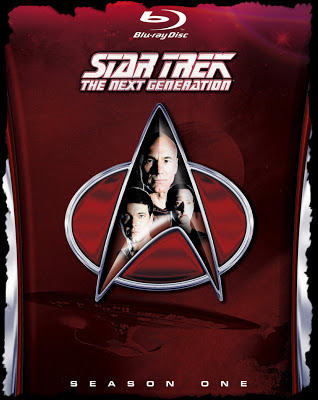 However, the documentary is careful not to incur the wrath of Trekkies everywhere even in its segments that suggest Roddenberry was detrimentally controlling; on the contrary, in fact. The fixated Roddenberry seems to have been more committed to his inspiring vision of the future than ever before, to the extent that he went so far as to effectively prohibit interpersonal conflict amongst the Enterprise’s crew due to his firm belief that even banter of the Spock / McCoy variety would no longer exist by the 2360s. To most writers, who believe that compelling character drama is borne of such conflict, particularly in long-running episodic television, this must have seemed like a ludicrous conceit at the time, yet it’s come to set The Next Generation’s characters apart from all those that followed them, and indeed all those that they followed. The crew of the Enterprise-D really are a band of “brothers and sisters” in all but the strictest sense, and for every lost Spock / Bones; Odo / Quark; Seven / everyone strained relationship, there’s a blind man teaching an android how to paint; a disciplined Frenchman successfully reining in and bringing out the best in a Klingon warrior; even a pair of star-crossed lovers letting go of the trappings of their long-since forsaken love life and becoming something that’s ostensibly less, yet somehow more.
However, the documentary is careful not to incur the wrath of Trekkies everywhere even in its segments that suggest Roddenberry was detrimentally controlling; on the contrary, in fact. The fixated Roddenberry seems to have been more committed to his inspiring vision of the future than ever before, to the extent that he went so far as to effectively prohibit interpersonal conflict amongst the Enterprise’s crew due to his firm belief that even banter of the Spock / McCoy variety would no longer exist by the 2360s. To most writers, who believe that compelling character drama is borne of such conflict, particularly in long-running episodic television, this must have seemed like a ludicrous conceit at the time, yet it’s come to set The Next Generation’s characters apart from all those that followed them, and indeed all those that they followed. The crew of the Enterprise-D really are a band of “brothers and sisters” in all but the strictest sense, and for every lost Spock / Bones; Odo / Quark; Seven / everyone strained relationship, there’s a blind man teaching an android how to paint; a disciplined Frenchman successfully reining in and bringing out the best in a Klingon warrior; even a pair of star-crossed lovers letting go of the trappings of their long-since forsaken love life and becoming something that’s ostensibly less, yet somehow more.
 Indeed, even in their first season infancy, TNG’s stars each show great promise. Stewart’s Shakespearean-yet-somehow-fittingly-French Picard is instantly iconic; so different from Shatner’s lascivious and hasty Kirk, yet so unobtrusively dominant that he makes it difficult to imagine anyone else ever sitting in the captain’s chair. Data hits the ground running too, Brent Spiner immediately capturing the character’s compelling childlike wonder and innocence even as he’s led into an intoxicated Tasha Yar’s bedchamber. Geordi also makes an instant impact as the black and blind everyman; Troi too as the (only two-breasted, in the end) intergalactic cheerleader cum psychologist. I was even surprised by how palatable Wesley actually is when revisiting the episodes that he finds himself carrying – I’d remembered him as being far more insufferable. Perhaps Will Wheaton’s recent Big Bang Theory turns have softened my views. Will Riker, Worf and Beverley Crusher fare somewhat less well, although in the latter two’s case this is largely down to a lack of exposure (though the good doctor doesn’t help herself by allowing pretty much every patient that she treats over the course of the season to die), and in Riker’s it’s because he’s just playing a softened and subservient Kirk instead of the bearded audience anchor that he’d eventually become.
Indeed, even in their first season infancy, TNG’s stars each show great promise. Stewart’s Shakespearean-yet-somehow-fittingly-French Picard is instantly iconic; so different from Shatner’s lascivious and hasty Kirk, yet so unobtrusively dominant that he makes it difficult to imagine anyone else ever sitting in the captain’s chair. Data hits the ground running too, Brent Spiner immediately capturing the character’s compelling childlike wonder and innocence even as he’s led into an intoxicated Tasha Yar’s bedchamber. Geordi also makes an instant impact as the black and blind everyman; Troi too as the (only two-breasted, in the end) intergalactic cheerleader cum psychologist. I was even surprised by how palatable Wesley actually is when revisiting the episodes that he finds himself carrying – I’d remembered him as being far more insufferable. Perhaps Will Wheaton’s recent Big Bang Theory turns have softened my views. Will Riker, Worf and Beverley Crusher fare somewhat less well, although in the latter two’s case this is largely down to a lack of exposure (though the good doctor doesn’t help herself by allowing pretty much every patient that she treats over the course of the season to die), and in Riker’s it’s because he’s just playing a softened and subservient Kirk instead of the bearded audience anchor that he’d eventually become. 
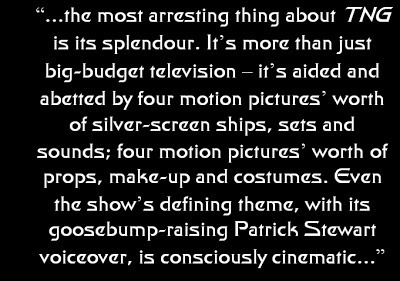 One of the strongest characters of this season, oddly, is Denise Crosby’s ill-fated Tasha Yar. Not only does the streetwise refugee turned security chief kick arse, but she’s surprisingly subtle at times, and always very articulate. Watching her episodes again, I noticed some really nice moments as she would explain things in a child’s terms to Wesley, or Data for that matter, while offering the likes of Geordi and Troi sympathetic shoulders as and when needed. It’s odd that she elected to leave the series as she felt that her character had little room for development within such a large ensemble, when in the series’ first twenty-two episodes only Picard, Wesley and Riker get more screen time. Yar’s always there, always contributing, right up until the closing moments of her final episode.
One of the strongest characters of this season, oddly, is Denise Crosby’s ill-fated Tasha Yar. Not only does the streetwise refugee turned security chief kick arse, but she’s surprisingly subtle at times, and always very articulate. Watching her episodes again, I noticed some really nice moments as she would explain things in a child’s terms to Wesley, or Data for that matter, while offering the likes of Geordi and Troi sympathetic shoulders as and when needed. It’s odd that she elected to leave the series as she felt that her character had little room for development within such a large ensemble, when in the series’ first twenty-two episodes only Picard, Wesley and Riker get more screen time. Yar’s always there, always contributing, right up until the closing moments of her final episode.
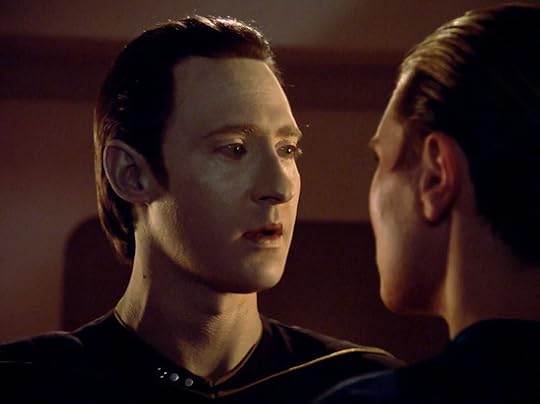 Probably my favourite thing about Season 1, though, is how it often subverts expectation. I remember watching later seasons of the show in the early 1990s on Sky One – 5pm daily, except on Thursdays and Fridays when a parental ruling would only allow me to watch the 10pm repeat showing, as my little sister insisted on watching the clashing Clarissa Explains It Allon another channel - and then catching the occasional BBC Two rerun of the original series, and being amazed at the difference. When I finally got to watch Season 1 of TNG, however, I couldn’t see much of one. If you look at some of its earliest episodes, many of which grew out of aborted Star Trek: Phase II scripts, it is just the original series but with a different crew and a dearth of humour - “Code of Honor” is a prime example. Yet as the season progresses, little flourishes of flavour start to surprise you, then the flavours increase in frequency and intensity. Picard failed his entrance exam to Starfleet Academy the first time around. Inviolate Earth is infiltrated by aliens. The Romulan Neutral Zone has been devastated by a not-instantly-revealed foe. A member of the bridge crew suffers a staggeringly-effective, blink-and-you’ll-miss-it death, which has since been made even more remarkable by virtue of the person in question having the decency to remain dead (which Spock, Kirk, Sisko, Data and Janeway all pointedly refused to do).
Probably my favourite thing about Season 1, though, is how it often subverts expectation. I remember watching later seasons of the show in the early 1990s on Sky One – 5pm daily, except on Thursdays and Fridays when a parental ruling would only allow me to watch the 10pm repeat showing, as my little sister insisted on watching the clashing Clarissa Explains It Allon another channel - and then catching the occasional BBC Two rerun of the original series, and being amazed at the difference. When I finally got to watch Season 1 of TNG, however, I couldn’t see much of one. If you look at some of its earliest episodes, many of which grew out of aborted Star Trek: Phase II scripts, it is just the original series but with a different crew and a dearth of humour - “Code of Honor” is a prime example. Yet as the season progresses, little flourishes of flavour start to surprise you, then the flavours increase in frequency and intensity. Picard failed his entrance exam to Starfleet Academy the first time around. Inviolate Earth is infiltrated by aliens. The Romulan Neutral Zone has been devastated by a not-instantly-revealed foe. A member of the bridge crew suffers a staggeringly-effective, blink-and-you’ll-miss-it death, which has since been made even more remarkable by virtue of the person in question having the decency to remain dead (which Spock, Kirk, Sisko, Data and Janeway all pointedly refused to do).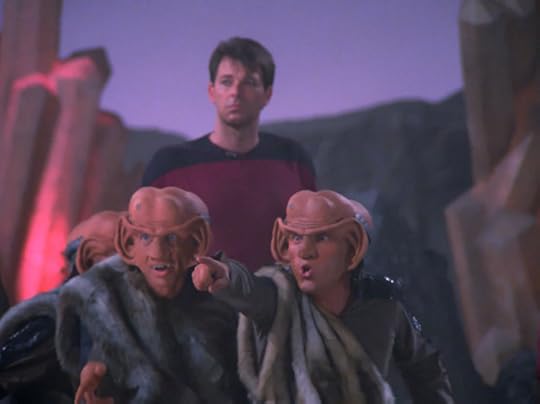 This initial run must also be credited with laying the foundations for the show’s future success, as well as that of its subsequent 24th century spin-offs. Between “Encounter at Farpoint” and “The Neutral Zone”, viewers are introduced to the Q Continuum; holodeck technology; the Ferengi; Lore; the legacy of the Khitomer Accords; the reinvention of the Prime Directive; and even, in oblique sort of way, the Borg threat. Whilst it’s true that some of these imaginative elements would not play out in the way that had originally been envisaged, the Ferengi especially so, their legacies have became as integral to the fabric of the Star Trek universe as the Vulcan nerve pinch or the merits of cheating on the Kobayashi Maru.
This initial run must also be credited with laying the foundations for the show’s future success, as well as that of its subsequent 24th century spin-offs. Between “Encounter at Farpoint” and “The Neutral Zone”, viewers are introduced to the Q Continuum; holodeck technology; the Ferengi; Lore; the legacy of the Khitomer Accords; the reinvention of the Prime Directive; and even, in oblique sort of way, the Borg threat. Whilst it’s true that some of these imaginative elements would not play out in the way that had originally been envisaged, the Ferengi especially so, their legacies have became as integral to the fabric of the Star Trek universe as the Vulcan nerve pinch or the merits of cheating on the Kobayashi Maru.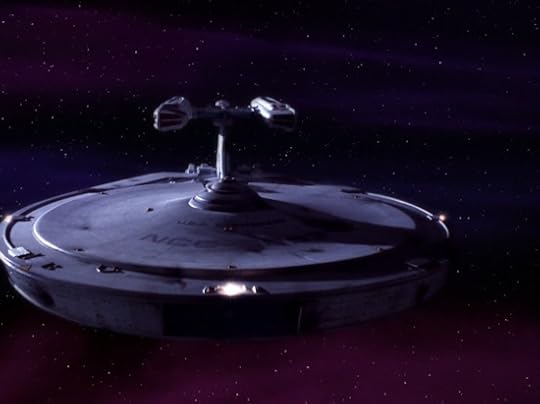 When watching the series on Blu-ray though, in stunning 1440 x 1080 resolution and with a DTS soundtrack that literally turns to your living room into one of the constantly-humming decks of the Enterprise-D, the most arresting thing about TNG is its splendour. It’s more than just big-budget television – it’s aided and abetted by four motion pictures’ worth of silver-screen ships, sets and sounds; four motion pictures’ worth of props, make-up and costumes. Even the show’s defining theme, with its goosebump-raising Patrick Stewart voiceover, is consciously cinematic, fusing the movie-remoulded Star Trek fanfare with The Motion Picture’s closing theme. Not only does it hold up today, but it bests almost every television show currently in production.
When watching the series on Blu-ray though, in stunning 1440 x 1080 resolution and with a DTS soundtrack that literally turns to your living room into one of the constantly-humming decks of the Enterprise-D, the most arresting thing about TNG is its splendour. It’s more than just big-budget television – it’s aided and abetted by four motion pictures’ worth of silver-screen ships, sets and sounds; four motion pictures’ worth of props, make-up and costumes. Even the show’s defining theme, with its goosebump-raising Patrick Stewart voiceover, is consciously cinematic, fusing the movie-remoulded Star Trek fanfare with The Motion Picture’s closing theme. Not only does it hold up today, but it bests almost every television show currently in production.
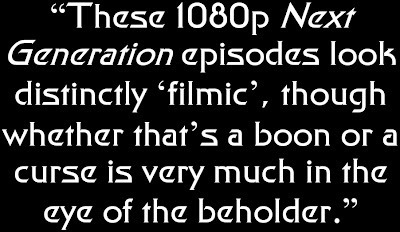 The season’s twenty-five episodes are presented in stunning 1920 x 1080 resolution, although only 1440 x 1080 of the frame contains the pillarboxed picture – the remainder is made up of black bars running down either side of the screen. Whilst I’m sure that most would have welcomed The Next Generation in 16:9 widescreen, unfortunately the programme was shot in 4:3 and at present the technology to convincingly ‘invent’ material to fill in the empty spaces doesn’t exist. Dependent on the specifications of your Blu-ray player or media centre, you may be able to zoom in on the 1080p image, should you so choose, though I’d advise against this as not only does it soften the image, but you lose part of the image altogether. Even were such losses acceptable, what you’d be watching wouldn’t be what the episodes’ directors agonised over framing.
The season’s twenty-five episodes are presented in stunning 1920 x 1080 resolution, although only 1440 x 1080 of the frame contains the pillarboxed picture – the remainder is made up of black bars running down either side of the screen. Whilst I’m sure that most would have welcomed The Next Generation in 16:9 widescreen, unfortunately the programme was shot in 4:3 and at present the technology to convincingly ‘invent’ material to fill in the empty spaces doesn’t exist. Dependent on the specifications of your Blu-ray player or media centre, you may be able to zoom in on the 1080p image, should you so choose, though I’d advise against this as not only does it soften the image, but you lose part of the image altogether. Even were such losses acceptable, what you’d be watching wouldn’t be what the episodes’ directors agonised over framing.The picture quality is nonetheless stunning. To their credit, rather than cheaply upscale standard definition video, CBS have instead retrieved and cleaned-up around twenty-five thousand reels of 35mm film negatives; digitised them in high definition; and then meticulously reconstructed each and every episode from the ground up, adhering strictly to the original in every case. The only changes that have been made have been to fix relatively minor visual gaffes that would probably escape notice; otherwise the much-loved episodes remain inviolate.
 I found the most striking aspects of these episodes to be their deep colour. The Next Generation’s standard definition episodes (and, indeed, Deep Space Nine and Voyager’s too) are decidedly dull in comparison, the signature hues of the crew’s Starfleet uniforms devoid of any vibrancy. Their HD counterparts, however, are loud and resplendently vital. The HD model shots are an even greater improvement, particularly those that feature the incredibly-detailed Enterprise-D - it says a lot about a programme when its opening shots can take your breath away. Each episode’s once-analogue soundtrack has also been deconstructed and reassembled in 7.1 DTS audio, to my ears putting them on a level pegging with most motion pictures’ dynamic soundscapes.
I found the most striking aspects of these episodes to be their deep colour. The Next Generation’s standard definition episodes (and, indeed, Deep Space Nine and Voyager’s too) are decidedly dull in comparison, the signature hues of the crew’s Starfleet uniforms devoid of any vibrancy. Their HD counterparts, however, are loud and resplendently vital. The HD model shots are an even greater improvement, particularly those that feature the incredibly-detailed Enterprise-D - it says a lot about a programme when its opening shots can take your breath away. Each episode’s once-analogue soundtrack has also been deconstructed and reassembled in 7.1 DTS audio, to my ears putting them on a level pegging with most motion pictures’ dynamic soundscapes.However, as with any HD media drawn from film, these episodes don’t look exactly like they’ve been shot with HD digital cameras. Every episodic television show that I watch at the moment looks incredibly sharp on my television, as they’re all shot in digital HD, whereas Blu-rays drawn from film prints always look a little grainier. I understand that this is because 35mm analogue film retains even more information than even something shot in 8K, but not all of the film’s information crystallises in a 1080p picture. These 1080p Next Generation episodes thus look distinctly ‘filmic’, though whether that’s a boon or a curse is very much in the eye of the beholder.
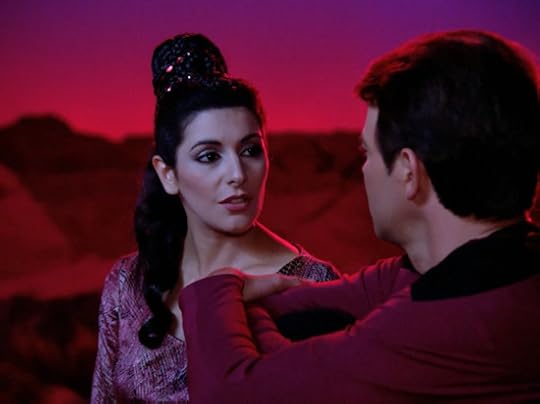 Unfortunately the Blu-ray discs are not without their faults, however – literally so, in fact, as I found out to my horror when I finally made it to “Haven”. On certain episodes, the DTS soundtrack is corrupt, possessing a bizarre, tinny echo that utterly ruins the surround sound experience. A quick Google search is all that it takes to identify the problem and put you on the road to obtaining replacement discs, and while you’re waiting the affected episodes’ (of which “11001001” appears to be the worst) original stereo soundtracks are perfectly listenable, but when you pay a premium for HD picture and sound, it’s an infuriating inconvenience. Another potential issue for some will be the discs’ streamlined packaging, which whilst much more likely to endure than the ornate but flimsy 2002 DVD box sets, will probably be a little too economical for collectors’ tastes. There’s not a booklet in sight as the discs’ basic contents are printed onto the underside of the Blu-ray sleeve, where they’re often obscured by the discs themselves. So frugal is the packaging, in fact, that unless you’re a real stickler for sky-high bitrates, it’s almost worth opting for the iTunes 1080p downloads instead. I throw in the qualifying ‘almost’ because neither is accompanied by any bonus material whatsoever, whereas the Blu-rays are absolutely saturated with it, and it’s all accessible through a beautiful HD Okudagram-style interface. Stardate Revisited and the DVDs’ archive mission logs are only the tip of the iceberg here - contemporary trailers, commentaries, a surprisingly naughty blooper reel, even the Energized! feature from The Next Level teaser Blu-ray – they’re all packed onto these six svelte discs.
Unfortunately the Blu-ray discs are not without their faults, however – literally so, in fact, as I found out to my horror when I finally made it to “Haven”. On certain episodes, the DTS soundtrack is corrupt, possessing a bizarre, tinny echo that utterly ruins the surround sound experience. A quick Google search is all that it takes to identify the problem and put you on the road to obtaining replacement discs, and while you’re waiting the affected episodes’ (of which “11001001” appears to be the worst) original stereo soundtracks are perfectly listenable, but when you pay a premium for HD picture and sound, it’s an infuriating inconvenience. Another potential issue for some will be the discs’ streamlined packaging, which whilst much more likely to endure than the ornate but flimsy 2002 DVD box sets, will probably be a little too economical for collectors’ tastes. There’s not a booklet in sight as the discs’ basic contents are printed onto the underside of the Blu-ray sleeve, where they’re often obscured by the discs themselves. So frugal is the packaging, in fact, that unless you’re a real stickler for sky-high bitrates, it’s almost worth opting for the iTunes 1080p downloads instead. I throw in the qualifying ‘almost’ because neither is accompanied by any bonus material whatsoever, whereas the Blu-rays are absolutely saturated with it, and it’s all accessible through a beautiful HD Okudagram-style interface. Stardate Revisited and the DVDs’ archive mission logs are only the tip of the iceberg here - contemporary trailers, commentaries, a surprisingly naughty blooper reel, even the Energized! feature from The Next Level teaser Blu-ray – they’re all packed onto these six svelte discs.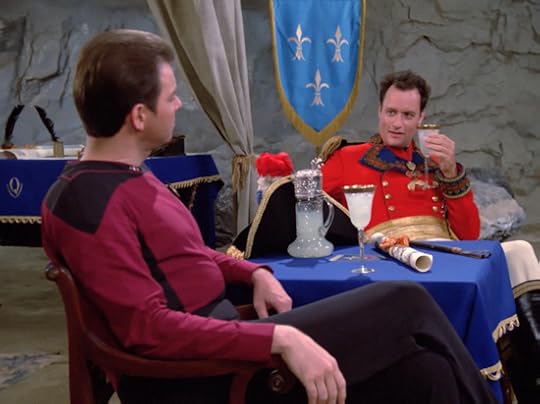
Overall then, the TNG HD experience is certainly a powerful one, even when it’s the show’s first and worst season under the microscope. The Blu-ray box set might come with a hefty price tag, but unlike its straight-transfer DVD counterpart (which was even more expensive than this box set when it was first released), I can’t say that I begrudge it. “The largest film restoration project ever attempted” looks to have been a real labour of love – one that I hope will revive interest in one of television’s greatest ever shows.
Star Trek: The Next Generation - Season One is available in 1080p HD on Blu-ray (cheapest price online today is £36.35 from Amazon ) and in digital format from iTunes (the whole season costs £40.99, but individual episodes can be bought for £2.49 each, save for the feature-length “Encounter at Farpoint”, which will set you back £4.98). The iTunes digital version does not include any of the bonus material discussed above.
Published on August 29, 2013 07:06
August 23, 2013
App Review | MyFitnessPal
I was a chubby, indolent child - and quite content to remain that way, until puberty brought with it a keen interest in the opposite gender, not to mention a testosterone-fuelled need to look better than, and indeed be stronger than, all my mates.
I started working out in the school gym at the age of fourteen, and then after leaving school purchased my first set of weights. Within a few years I went from a corpulent 150lbs (10st 10lbs) to a leaner and well-muscled 160lbs (11st 6lbs), and even during my time at university - an era in my life characterised by binge drinking and a total disinterest in nutrition - managed to keep in good shape through regular weight training and running.
Upon entering the world of work and marriage, however, my weight training was quick to fall by the wayside, and the road to Fat Hell was blocked only by my financially-motivated insistence upon walking to and running home from work and being press-ganged into the occasional long, steep walk. From time to time, usually when egged on by my uncle, I’d drop weight and excel with my running and fell walking - on a sweltering day in the summer of 2009 I finished the Humber Bridge Half Marathon in 1:37:47; on 2nd May 2010, my uncle and I completed the Yorkshire “Three Peaks Challenge” (a 26-mile fell walk encompassing Pen-y-Ghent, Whernside and Ingleborough) in 8 hours and 20 minutes; and on a chilly October morn in 2010 I ran the Bridlington Half Marathon in a personal best of 1:29:41 -, but, more often than not, I’d binge without a thought for my burgeoning frame.
Matters reached a head in early 2011, when I was diagnosed with psoriatic arthritis - an aggressive disease that turns your own immune system against you, targeting your joints and attacking them with the same gusto that it would an invading pathogen. Initially only the joints in a few of my fingers and my dominant right thumb were affected, but within months I presented with more significant problems in my right knee and left foot that made it extremely painful to walk with a normal gait, let alone run, and ultimately put paid to me doing any meaningful form of exercise. When my daughter was born in 2011, my battle for fitness went nuclear - by 1st January 2013, I weighed a (for 5’ 10”) stout 12st 4lbs (172lbs), and the only muscle to be seen anywhere on me were half-hearted lumps where my biceps used to be.

Inspired by my bodybuilding rock of a brother and aided by a immunosuppressant drug that’s turned my urine a bilious yellow but almost halted the progression of and reduced the symptoms of my psoriatic arthritis, I’ve already shed the most offensive of the fat that once encased me, and now I’m working hard to not only to regain the long-lost muscle mass of my youth, but gain better definition too. As you may have gathered from the stat-filled potted history above, I’m a bit of a geek when it comes to data collection and retention, and it’s no coincidence that peaks in my personal fitness levels have coincided with spells in my life when I’ve felt compelled to keep lists detailing my running times and daily calorie intake. Today I’m fortunate in that there are a number of apps available that do all the donkey work for me, obviating the need for laborious booting and logging, and increasing the chances of long-term success. The most effective of these is MyFitnessPal (available free from Apple’s iTunes App Store), which I use between my iPhone and iPad, dependent on where I am.
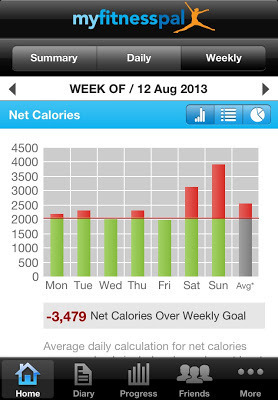 At its most basic, the app syncs with your online MyFitnessPal account (it’s quick, easy, and most importantly of all, free to sign up) where you can set your initial goals (these can be tweaked later within the app itself). You can set yourself a goal weight, and even the rate by which you want to lose or gain weight, and MyFitnessPal will calculate the net caloric intake required to achieve your goal. Every time that you have a bite to eat, or something to drink, you simply scan the product’s barcode and, more often than not, its nutritional information will be instantly imported into your MyFitnessPal food diary and offset against your gross daily total. If your food or drink doesn’t have a barcode, you can simply search for it manually, and to my delight the database includes a wide range of (particularly franchised) restaurant dishes as well as common homemade staples. Anything that isn’t there, you can easily add yourself.
At its most basic, the app syncs with your online MyFitnessPal account (it’s quick, easy, and most importantly of all, free to sign up) where you can set your initial goals (these can be tweaked later within the app itself). You can set yourself a goal weight, and even the rate by which you want to lose or gain weight, and MyFitnessPal will calculate the net caloric intake required to achieve your goal. Every time that you have a bite to eat, or something to drink, you simply scan the product’s barcode and, more often than not, its nutritional information will be instantly imported into your MyFitnessPal food diary and offset against your gross daily total. If your food or drink doesn’t have a barcode, you can simply search for it manually, and to my delight the database includes a wide range of (particularly franchised) restaurant dishes as well as common homemade staples. Anything that isn’t there, you can easily add yourself.
Where I’ve found the app really comes into its own though is through its recording of exercise. Until such time as my bro has completed his evaluation of just about every GPS ‘map my run’-style app on the market, I’m using Runtastic Pro (£2.99 from Apple’s iTunes App Store) to record my own runs and strolls, which – once you’ve connected the two apps in the touch of a button - MyFitnessPal automatically imports, offsetting the estimated calorie burn against your gross daily target. From the point of view of someone looking to lose weight, this is a great motivator to exercise, as burning 900 or so calories on a 90-minute run means that you can eat quite freely and probably still be under your daily calorie goal, whereas for someone like me who’s trying to gain muscle mass, it helps to ensure that you aren’t totally killing your gains with excessive aerobic burn.
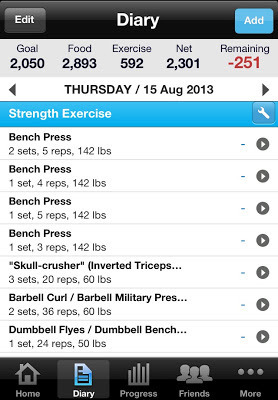 Another boon for me is the integration of your exercise diary into the app, which allows you to manually add any type of exercise that you’ve done and again claim the estimated calories for it. This is handy if you don’t use a GPS tracker to record your walks and runs, or if you regularly partake in some other form of aerobic exercise, but it’s also invaluable to keep track on strength training. As you’ll see from the screengrab (right), you can record each individual weight-lifting exercise that you do, detailing the weight used and the number of reps achieved, allowing you to keep track of your progress and also spot correlations between food intake and good days / bad days in the gym. You can even record an overall session in the gym as a ‘cardio’ exercise, and MyFitnessPal will estimate your calorie burn for the session. My brother’s of the firm view that the app massively overestimates how many calories are burnt during anaerobic exercise, but I’m not convinced on the point; not unless my metabolism is a veritable furnace, anyway, otherwise I’d be a lot heavier than I am. A final plus point on the diary is the ability to add both food and excercise notes (or, more often than not, excuses).
Another boon for me is the integration of your exercise diary into the app, which allows you to manually add any type of exercise that you’ve done and again claim the estimated calories for it. This is handy if you don’t use a GPS tracker to record your walks and runs, or if you regularly partake in some other form of aerobic exercise, but it’s also invaluable to keep track on strength training. As you’ll see from the screengrab (right), you can record each individual weight-lifting exercise that you do, detailing the weight used and the number of reps achieved, allowing you to keep track of your progress and also spot correlations between food intake and good days / bad days in the gym. You can even record an overall session in the gym as a ‘cardio’ exercise, and MyFitnessPal will estimate your calorie burn for the session. My brother’s of the firm view that the app massively overestimates how many calories are burnt during anaerobic exercise, but I’m not convinced on the point; not unless my metabolism is a veritable furnace, anyway, otherwise I’d be a lot heavier than I am. A final plus point on the diary is the ability to add both food and excercise notes (or, more often than not, excuses).
Another feature that I find useful is the ability to track my progress, and have MyFitnessPal plot graphs, pie charts and the like. As weight variation isn’t always indicative of progress, particularly if your goals are more complicated than to just lose weight, it’s helpful to be able to track measurements (waist, chest, biceps etc) as well as levels of body fat and body water to ensure that you’re moving forward. This has been particularly good for me as my weight has recently plateaued, but I can at least observe a trend of steady muscle growth and fat reduction (and continue to enjoy a 3,000 – 4,000 calories per day diet!)
One complaint that I do have though is the app’s patent weight loss bias. It’s quick to give you a slap on the back if your weight has fallen, or you’re under your daily calorie target, but if you gain a pound the colour changes from green to red and you don’t get any encouragement whatsoever. This would be relatively easy to invert dependent upon an individual’s goals, and I hope will be taken into account within a future update.
A final feature worthy of mention is the app’s social networking side, which I don’t use – I’ve deliberately used a distorted, ‘fat man’ profile picture to deter friend requests – but I can see the benefit of for some people. My brother has a decent following on there that keeps us both constantly amused – the well-meaning comments of other users crack me up daily. The other day the app had posted that my brother had logged in for 65 days in a row, to which some supportive soul had commented, “Nice logging!” That said, the forums on the MyFitnessPal website are full of clued-up people dispensing free dietary advice, so it’s probably worth putting up with the odd bit of mindless enthusiasm for what you get in return.

And so if you’ve got a smartphone or tablet, and are prepared to run the divorce gauntlet by irritating your spouse with constant barcode scanning, then the free MyFitnessPal app is an absolute must. I prefer the iPad version for ease of viewing (the diary display is much more detailed, allowing me to keep tabs on my protein intake) and the iPhone version for use on the move, but whatever device you’re using, with MyFitnessPal on it you’ve got a much better chance of meeting your fitness goals.
I started working out in the school gym at the age of fourteen, and then after leaving school purchased my first set of weights. Within a few years I went from a corpulent 150lbs (10st 10lbs) to a leaner and well-muscled 160lbs (11st 6lbs), and even during my time at university - an era in my life characterised by binge drinking and a total disinterest in nutrition - managed to keep in good shape through regular weight training and running.
Upon entering the world of work and marriage, however, my weight training was quick to fall by the wayside, and the road to Fat Hell was blocked only by my financially-motivated insistence upon walking to and running home from work and being press-ganged into the occasional long, steep walk. From time to time, usually when egged on by my uncle, I’d drop weight and excel with my running and fell walking - on a sweltering day in the summer of 2009 I finished the Humber Bridge Half Marathon in 1:37:47; on 2nd May 2010, my uncle and I completed the Yorkshire “Three Peaks Challenge” (a 26-mile fell walk encompassing Pen-y-Ghent, Whernside and Ingleborough) in 8 hours and 20 minutes; and on a chilly October morn in 2010 I ran the Bridlington Half Marathon in a personal best of 1:29:41 -, but, more often than not, I’d binge without a thought for my burgeoning frame.
Matters reached a head in early 2011, when I was diagnosed with psoriatic arthritis - an aggressive disease that turns your own immune system against you, targeting your joints and attacking them with the same gusto that it would an invading pathogen. Initially only the joints in a few of my fingers and my dominant right thumb were affected, but within months I presented with more significant problems in my right knee and left foot that made it extremely painful to walk with a normal gait, let alone run, and ultimately put paid to me doing any meaningful form of exercise. When my daughter was born in 2011, my battle for fitness went nuclear - by 1st January 2013, I weighed a (for 5’ 10”) stout 12st 4lbs (172lbs), and the only muscle to be seen anywhere on me were half-hearted lumps where my biceps used to be.

Inspired by my bodybuilding rock of a brother and aided by a immunosuppressant drug that’s turned my urine a bilious yellow but almost halted the progression of and reduced the symptoms of my psoriatic arthritis, I’ve already shed the most offensive of the fat that once encased me, and now I’m working hard to not only to regain the long-lost muscle mass of my youth, but gain better definition too. As you may have gathered from the stat-filled potted history above, I’m a bit of a geek when it comes to data collection and retention, and it’s no coincidence that peaks in my personal fitness levels have coincided with spells in my life when I’ve felt compelled to keep lists detailing my running times and daily calorie intake. Today I’m fortunate in that there are a number of apps available that do all the donkey work for me, obviating the need for laborious booting and logging, and increasing the chances of long-term success. The most effective of these is MyFitnessPal (available free from Apple’s iTunes App Store), which I use between my iPhone and iPad, dependent on where I am.
 At its most basic, the app syncs with your online MyFitnessPal account (it’s quick, easy, and most importantly of all, free to sign up) where you can set your initial goals (these can be tweaked later within the app itself). You can set yourself a goal weight, and even the rate by which you want to lose or gain weight, and MyFitnessPal will calculate the net caloric intake required to achieve your goal. Every time that you have a bite to eat, or something to drink, you simply scan the product’s barcode and, more often than not, its nutritional information will be instantly imported into your MyFitnessPal food diary and offset against your gross daily total. If your food or drink doesn’t have a barcode, you can simply search for it manually, and to my delight the database includes a wide range of (particularly franchised) restaurant dishes as well as common homemade staples. Anything that isn’t there, you can easily add yourself.
At its most basic, the app syncs with your online MyFitnessPal account (it’s quick, easy, and most importantly of all, free to sign up) where you can set your initial goals (these can be tweaked later within the app itself). You can set yourself a goal weight, and even the rate by which you want to lose or gain weight, and MyFitnessPal will calculate the net caloric intake required to achieve your goal. Every time that you have a bite to eat, or something to drink, you simply scan the product’s barcode and, more often than not, its nutritional information will be instantly imported into your MyFitnessPal food diary and offset against your gross daily total. If your food or drink doesn’t have a barcode, you can simply search for it manually, and to my delight the database includes a wide range of (particularly franchised) restaurant dishes as well as common homemade staples. Anything that isn’t there, you can easily add yourself.Where I’ve found the app really comes into its own though is through its recording of exercise. Until such time as my bro has completed his evaluation of just about every GPS ‘map my run’-style app on the market, I’m using Runtastic Pro (£2.99 from Apple’s iTunes App Store) to record my own runs and strolls, which – once you’ve connected the two apps in the touch of a button - MyFitnessPal automatically imports, offsetting the estimated calorie burn against your gross daily target. From the point of view of someone looking to lose weight, this is a great motivator to exercise, as burning 900 or so calories on a 90-minute run means that you can eat quite freely and probably still be under your daily calorie goal, whereas for someone like me who’s trying to gain muscle mass, it helps to ensure that you aren’t totally killing your gains with excessive aerobic burn.
 Another boon for me is the integration of your exercise diary into the app, which allows you to manually add any type of exercise that you’ve done and again claim the estimated calories for it. This is handy if you don’t use a GPS tracker to record your walks and runs, or if you regularly partake in some other form of aerobic exercise, but it’s also invaluable to keep track on strength training. As you’ll see from the screengrab (right), you can record each individual weight-lifting exercise that you do, detailing the weight used and the number of reps achieved, allowing you to keep track of your progress and also spot correlations between food intake and good days / bad days in the gym. You can even record an overall session in the gym as a ‘cardio’ exercise, and MyFitnessPal will estimate your calorie burn for the session. My brother’s of the firm view that the app massively overestimates how many calories are burnt during anaerobic exercise, but I’m not convinced on the point; not unless my metabolism is a veritable furnace, anyway, otherwise I’d be a lot heavier than I am. A final plus point on the diary is the ability to add both food and excercise notes (or, more often than not, excuses).
Another boon for me is the integration of your exercise diary into the app, which allows you to manually add any type of exercise that you’ve done and again claim the estimated calories for it. This is handy if you don’t use a GPS tracker to record your walks and runs, or if you regularly partake in some other form of aerobic exercise, but it’s also invaluable to keep track on strength training. As you’ll see from the screengrab (right), you can record each individual weight-lifting exercise that you do, detailing the weight used and the number of reps achieved, allowing you to keep track of your progress and also spot correlations between food intake and good days / bad days in the gym. You can even record an overall session in the gym as a ‘cardio’ exercise, and MyFitnessPal will estimate your calorie burn for the session. My brother’s of the firm view that the app massively overestimates how many calories are burnt during anaerobic exercise, but I’m not convinced on the point; not unless my metabolism is a veritable furnace, anyway, otherwise I’d be a lot heavier than I am. A final plus point on the diary is the ability to add both food and excercise notes (or, more often than not, excuses).Another feature that I find useful is the ability to track my progress, and have MyFitnessPal plot graphs, pie charts and the like. As weight variation isn’t always indicative of progress, particularly if your goals are more complicated than to just lose weight, it’s helpful to be able to track measurements (waist, chest, biceps etc) as well as levels of body fat and body water to ensure that you’re moving forward. This has been particularly good for me as my weight has recently plateaued, but I can at least observe a trend of steady muscle growth and fat reduction (and continue to enjoy a 3,000 – 4,000 calories per day diet!)
One complaint that I do have though is the app’s patent weight loss bias. It’s quick to give you a slap on the back if your weight has fallen, or you’re under your daily calorie target, but if you gain a pound the colour changes from green to red and you don’t get any encouragement whatsoever. This would be relatively easy to invert dependent upon an individual’s goals, and I hope will be taken into account within a future update.
A final feature worthy of mention is the app’s social networking side, which I don’t use – I’ve deliberately used a distorted, ‘fat man’ profile picture to deter friend requests – but I can see the benefit of for some people. My brother has a decent following on there that keeps us both constantly amused – the well-meaning comments of other users crack me up daily. The other day the app had posted that my brother had logged in for 65 days in a row, to which some supportive soul had commented, “Nice logging!” That said, the forums on the MyFitnessPal website are full of clued-up people dispensing free dietary advice, so it’s probably worth putting up with the odd bit of mindless enthusiasm for what you get in return.

And so if you’ve got a smartphone or tablet, and are prepared to run the divorce gauntlet by irritating your spouse with constant barcode scanning, then the free MyFitnessPal app is an absolute must. I prefer the iPad version for ease of viewing (the diary display is much more detailed, allowing me to keep tabs on my protein intake) and the iPhone version for use on the move, but whatever device you’re using, with MyFitnessPal on it you’ve got a much better chance of meeting your fitness goals.
Published on August 23, 2013 06:14
August 13, 2013
Book Review | Porno by Irvine Welsh

Almost a decade ago now, when my teacher training was in its death throes, I’d regularly cite either this book or the author’s earlier Filth as being my favourite reading material whenever the topic arose in workshops or seminars. Not because they were, you understand; just because it provoked either an amused or judgemental reaction, the achievement of which was just about the only reasons for my continuing, sporadic attendances (the other being the continued receipt of my bursaries and loan instalments). The thing is though, both truly are superlative titles, and whilst I’m not one for favourites, Irvine Welsh’s 2002 sequel to both Trainspotting and Glue is perhaps the one book in his canon that showcases a little of everything that the Scots scribbler brings to the table - a ‘best of’, if you will, rather than an outright best.
“If the word in the eighties was ‘me’, and in the nineties ‘it’, in the millennium it’s ‘ish’. Everything has to be vague and qualified. Substance used to be important, then style was everything. Now it’s all just faking it.”
It is nonetheless a very different beast to Trainspotting, most obviously because it is a novel in the traditional sense, with all the structure and plot threads that you’d expect thereto, rather than a series of snippets that are, by and large, capable of being enjoyed in isolation. Another significant difference is focus - Trainspottingwill forever be synonymous with heroin, whereas in Porno it barely gets a mention, as most of its characters are now only partial to the peeve or a bit of ching. Indeed, as most would readily infer from the title, this book’s focus is the world of adult erotica, from Juice Terry’s stag movies shot in the upstairs of a Leith tavern, all the way up to the Cannes (Adult) Film Festival, and all the aspirant undergraduates in between.
“In your twenties you can do it on looks, your thirties on personality, but in your forties you need cash or fame. Simple fucking mathematics.”
And whilst many paperback editions of the book are emblazoned with the same names burned into Britain’s collective consciousness thanks to the fame that they found through the 1996 Trainspotting movie’s ubiquitous mock-identity parade posters, Pornoactually focuses on just one of them: Simon David Williamson, the above-mentioned ‘Sick Boy’. Whilst his three famous friends (four, if you count Dianne, who’s gained an extra ‘n’ since her silver screen days) all have pivotal parts to play, Porno is driven by Sick Boy - which is really quite fitting, given that it’s about Sick Boy’s drive.
“Sick Boy: vain, selfish and cruel. And that’s his good side.”
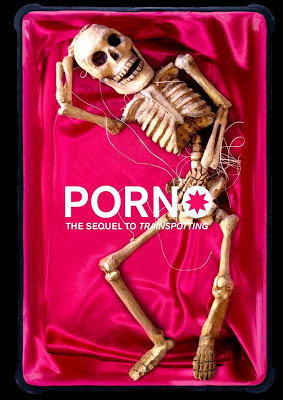 The plot focuses on Felinus Vomitus’s quest to make a “proper” adult “fillum” and the scams that he pursues in and around it. Time has marched on since his former best friend, Mark Renton, “chose life” and did a runner with drug money belonging to both him and their psychotic associate, Franco Begbie. Sick Boy’s been married since, and indeed divorced. The Beggar Boy’s inevitably in the nick, serving a murder-reduced-to-manslaughter charge. Loveable Spud is living unhappily ever after, off the junk and married to Ali, but trying and failing to write a book on the history of Leith. Erstwhile jailbait Dianne is at university, reading psychology and writing a dissertation of the sex industry. The Rent Boy, meanwhile, is running a nightclub in Amsterdam, and it is here that a chance encounter with an Edinburgh DJ (Glue’s N-Sign) leads to an unwelcome reunion with one of the men that he screwed over. Before long, Sick Boy and Rents are superficially as thick as thieves again, agreeing to put their differences behind them and form a porn-pedalling partnership. In truth, though, one man is trying to manipulate circumstances to get the other killed, who in turn is setting in motion an extravagant plan to rob his once-best friend for the second time in as many books, but this time on a much larger scale.
The plot focuses on Felinus Vomitus’s quest to make a “proper” adult “fillum” and the scams that he pursues in and around it. Time has marched on since his former best friend, Mark Renton, “chose life” and did a runner with drug money belonging to both him and their psychotic associate, Franco Begbie. Sick Boy’s been married since, and indeed divorced. The Beggar Boy’s inevitably in the nick, serving a murder-reduced-to-manslaughter charge. Loveable Spud is living unhappily ever after, off the junk and married to Ali, but trying and failing to write a book on the history of Leith. Erstwhile jailbait Dianne is at university, reading psychology and writing a dissertation of the sex industry. The Rent Boy, meanwhile, is running a nightclub in Amsterdam, and it is here that a chance encounter with an Edinburgh DJ (Glue’s N-Sign) leads to an unwelcome reunion with one of the men that he screwed over. Before long, Sick Boy and Rents are superficially as thick as thieves again, agreeing to put their differences behind them and form a porn-pedalling partnership. In truth, though, one man is trying to manipulate circumstances to get the other killed, who in turn is setting in motion an extravagant plan to rob his once-best friend for the second time in as many books, but this time on a much larger scale.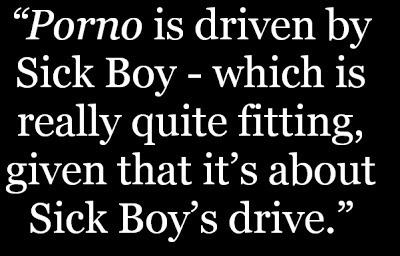 It’s refreshing to follow these events mostly through the eyes of the book’s antagonists, as both Trainspottingand its recent sequel, Skagboys, settle upon the generally more amiable Renton as their voice. Sick Boy dominates, Welsh’s first person prose allowing the reader to see the proud and prejudiced turning of every cog in his mind, but Begbie gets more exposure than he ever has too, offering a frighteningly narrow perspective that’s constantly flitting between terrifying and comically tragic. The reader can almost see the old psycho blossom into “a deep fuckin thinker” here, believe it or not, as those “blazing coals of enmity” set deep in his skull are finally opened to the fact that he may be the toughest son of bitch in the old port, but ultimately he’s everybody’s mug; nowt more than a weapon to be wielded.
It’s refreshing to follow these events mostly through the eyes of the book’s antagonists, as both Trainspottingand its recent sequel, Skagboys, settle upon the generally more amiable Renton as their voice. Sick Boy dominates, Welsh’s first person prose allowing the reader to see the proud and prejudiced turning of every cog in his mind, but Begbie gets more exposure than he ever has too, offering a frighteningly narrow perspective that’s constantly flitting between terrifying and comically tragic. The reader can almost see the old psycho blossom into “a deep fuckin thinker” here, believe it or not, as those “blazing coals of enmity” set deep in his skull are finally opened to the fact that he may be the toughest son of bitch in the old port, but ultimately he’s everybody’s mug; nowt more than a weapon to be wielded.“I always thought that Terry’s cock would get him into trouble, everybody in the scheme used tae say that. We never thought that hewould get it into trouble though!”
More surprising still is the attention given to non-Trainspotting characters. ‘Juice’ Terry Lawson and Rab Birrell of Glue fame both feature heavily in the first half of the book, though Welsh - much like Sick Boy, ironically - only uses the former as an eager prick, and the latter as a ready-made road into the undergraduate world of the book’s female players. This is a little disappointing as “the best-known aerated waters’ salesman” that Edinburgh ever produced, even when he’s purely there to find wood, is so relentlessly entertaining that he’s sorely missed once he falls by the wayside, while Rab’s storyline just peters out, left in desperate need of a coda. The female contingent, however, are used exceptionally well, from the studious and repressed Lauren all the way up to fiery Reading diva Nicola Fuller-Smith, who is in my view the book’s real star. Porno is, after all, all about the girls.
“It’s not the penises that are the problem, it’s the attachments; they come in varying sizes alright, varying sizes and degrees of annoyance.”
I knew a number of girls like Nikki in my university days - outwardly intelligent, independent, ambitious, fit as fuck and don’t they know it, yet silently tortured by well-hidden low self-esteem and jealously that leave them vulnerable to exploitation by the likes of our Mr Williamson. It’s been well reported that Welsh has a keen academic interest in the study of feminism (his MBA’s thesis was on creating equal opportunities for women), and to my delight this is often embodied by his strong female characters, but in a way that eschews cliché or even subverts expectation. Nikki might not be quite as indomitable as one of Welsh’s Wedding Belles, and she may have admittedly poor wanking skills for a part-time masseuse, but any male reader is sure to follow every male character in the book and fall instantly in love with her, and thus find themselves on a rollercoaster ride that takes in arousal, anger and utter vexation before she finally manages to have her cake, eat it, and then throw it up before it can damage her (you’ve got to give it to Welsh, he’s got a gift for squalid metaphor).
“Impotence is bad and clinginess is awful, but the two in tandem simply can’t be tolerated.”
Perhaps the most remarkable thing of all about Pornothough is that it’s actually quite light on how’s your father. For me, the images of Del Boy and Rodney conjured by the original edition’s blow-up doll cover aren’t all that out of place as, for all its base and shallow cruelty, Porno is quite a hoot. It mischievously toys with Begbie’s sexuality, for instance, running a little with the aspersions cast by the actor who played him on screen by bombarding him with “poof’s porn” in prison and then rendering him impotent upon his release when he tries to get a ride from his new squeeze. Poor old Terry, meanwhile, is treated like he’s in a particularly lewd Carry Onfilm, enjoying only a few R-rated scenes as a “fly-in-shit with all his needs met” before his banjo string snaps, and doctors tell him that a hard-on during the healing process could lead to the amputation of his penis, leading to a hilarious precession of gags involving his female Seven Rides for Seven Brothers co-stars. When things do heat up, though, the man who’s called ‘Welsh’ despite his patent Scottish pedigree holds his own against the dominating mummy porn pioneers of today, vesting Sick Boy and Nikki’s nuclear war of a lovelife with a vividly-described physical passion that certainly wouldn’t pass censorship should Danny Boyle et al ever elect to try and reassemble the old team and bring Trainspotting’s sequel to film.
“You’ve got two categories. Category one: me. Category two: the rest of the world. You can divide the others up into two sub-groups: those who do as I say, and the superfluous.”
However, Porno was never going to find itself on a pedestal like Trainspotting because Trainspotting was such a specific and insightful thing; a cultural pipe bomb. This is a pity, really, as Porno deserves better than second prize - it’s just as thoughtful as its predecessor, in many ways, offering as balanced an appraisal of the sex trade, pornographers and prostitutes as Trainspotting did of hard drugs. And this time around, the appraisal is at least couched in the more familiar guise of a tortuous and relentlessly gripping narrative, which when combined with a female English antiheroine, might make it a great deal more accessible for those who’ve only seen the Trainspottingmovie but want to pick things up here and chase the ride.
Irvine Welsh’s Porno is currently available in paperback (best price online today: £5.44 from AbeBooks) and digital formats (£5.22 from Amazon's Kindle Store or £5.49 from iTunes).
Published on August 13, 2013 05:39
Beyond History's End | 50th Anniversary Doctor Who Review 7 of 12 | UNIT: Dominion written by Nicholas Briggs and Jason Arnopp

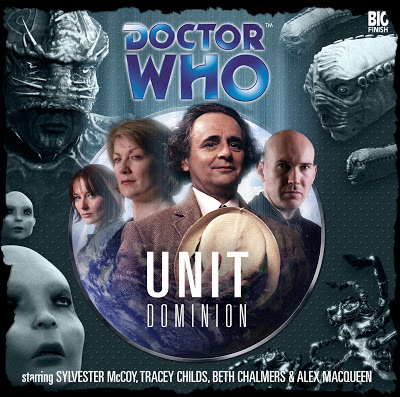 Ever since the classic series’ cancellation, one of Doctor Who’s most persistent rumours has been that another Doctor Who feature film is just around the next corner. Yet, unless you count a TV movie, which is closer to a feature-length telly pilot than it is the colourful Peter Cushing box office smashes of yesteryear, nothing has ever come of them. I’ve never been too troubled by this though, as such an enterprise would probably turn out to be a complete reimagining of the series built around some Hollywood hunk in a scarf, or just a really long and effects-driven episode starring the series’ incumbent Doctor. But then I listened to UNIT: Dominion, and promptly decided that if the series does ever return to the silver screen, all that the moviemakers would need to do to keep me happy is to put pictures to the already-cinematic sounds of this Nicholas Briggs / Jason Arnopp audio epic.
Ever since the classic series’ cancellation, one of Doctor Who’s most persistent rumours has been that another Doctor Who feature film is just around the next corner. Yet, unless you count a TV movie, which is closer to a feature-length telly pilot than it is the colourful Peter Cushing box office smashes of yesteryear, nothing has ever come of them. I’ve never been too troubled by this though, as such an enterprise would probably turn out to be a complete reimagining of the series built around some Hollywood hunk in a scarf, or just a really long and effects-driven episode starring the series’ incumbent Doctor. But then I listened to UNIT: Dominion, and promptly decided that if the series does ever return to the silver screen, all that the moviemakers would need to do to keep me happy is to put pictures to the already-cinematic sounds of this Nicholas Briggs / Jason Arnopp audio epic.Big Finish are, of course, masters when it comes to painting pictures with sounds, but with this sprawling story they’ve reached fantastic new heights. Comprised of four feature-length instalments ranging from an hour to eighty minutes in length, UNIT: Dominion might be one long adventure, but it is one comprised of many discrete segments, each of which has its own monster of the week. From “mind leeches” to “energy vampires” to perhaps the most unsettling alien creatures ever seen or heard in Who, the colossal and cherubic “Skyheads”, this story bombards the listener with one powerful and nightmarish image after another, each larger and more vivid than the last. And whilst sound designer and musician Martin Johnson can take some of the plaudits for the realisation of these images, the truth is that they’re as much the product of the masterfully-written dialogue as they are the beguiling soundscape layered beneath it.
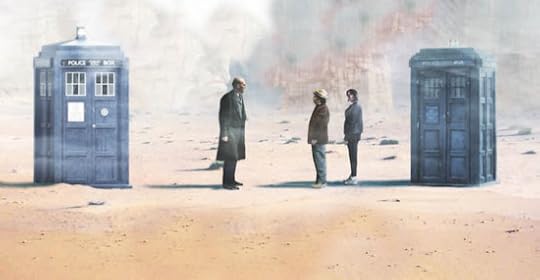
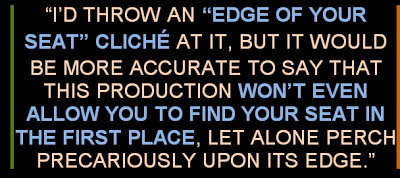 More remarkable still is the story’s sense of scope, which even after listening to it twice, I’m still struggling to take in fully. Answering a distress call from a race that his apparent future self has warned him not to trust, the true-to-himself-right-now seventh Doctor is lured into a situation in which he’s forced to break down the walls between dimensions in order to save his companion Raine’s life. The consequences of him so doing are evident to the listener before he’s even entered the tale, as on now-ish Earth, incursions are coming thick and fast from all manner of extra-dimensional creatures, and it’s up to UNIT to try to repel them. The only trouble is, UNIT’s latest CO, Colonel Lafayette, is an empty-headed twit, and even his fiercely-efficient scientific advisor is experiencing psychological problems thanks to the “Umbrella Man” who’s taken up residence in the corner of her eye, from where he’s keeping tabs on whether or not she’s “invading Poland”. It’s fortunate, then, that an overblown incarnation of the Doctor not yet known to UNIT arrives when he does to offer his assistance. Or so it might seem.
More remarkable still is the story’s sense of scope, which even after listening to it twice, I’m still struggling to take in fully. Answering a distress call from a race that his apparent future self has warned him not to trust, the true-to-himself-right-now seventh Doctor is lured into a situation in which he’s forced to break down the walls between dimensions in order to save his companion Raine’s life. The consequences of him so doing are evident to the listener before he’s even entered the tale, as on now-ish Earth, incursions are coming thick and fast from all manner of extra-dimensional creatures, and it’s up to UNIT to try to repel them. The only trouble is, UNIT’s latest CO, Colonel Lafayette, is an empty-headed twit, and even his fiercely-efficient scientific advisor is experiencing psychological problems thanks to the “Umbrella Man” who’s taken up residence in the corner of her eye, from where he’s keeping tabs on whether or not she’s “invading Poland”. It’s fortunate, then, that an overblown incarnation of the Doctor not yet known to UNIT arrives when he does to offer his assistance. Or so it might seem.
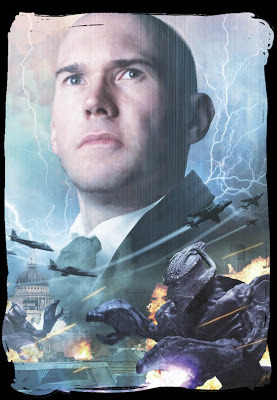 There are so many fascinating, competing threads here that, at any one time, listeners have a number of unanswered questions blazing away in their imaginations, not least of which is the identity of this alleged future Doctor, who’s magnificently given life by Alex Macqueen - the man behind the villain of the Colin Baker Lost Story, Paradise 5; an anti-speedbump campaign in Outnumbered; and, most famously, Inbetweener Neil’s “bumder” father. Macqueen’s even been in the thick of it with television’s next Doctor, Peter Capaldi, which, incidentally, is the reason why savvy listeners won’t accept him at face value for a second - Big Finish’s licence doesn’t cover the Doctors of the revived series, which by definition must include all incarnations yet to be seen. And Macqueen’s embroidered performance doesn’t do much to convince us otherwise - he outdoes The Next Doctor’s David Morrissey and perhaps even The One Doctor’s Christopher Biggins in the deliberate-ham stakes. Yet there is a “dimensional crisis” going on here, and whilst UNIT: Dominion seems to follow Season 26’s Battlefield(and the original Teenage Mutant Ninja Turtles cartoon...) by suggesting that these dimensions are physical planes rather than quantum states, until the truth about him is revealed, the listener can’t rule out the possibility that Macqueen’s Doctor is some Unboundalternative of the Doctor, but a Doctor nonetheless. Even when he conducts himself in an unDoctorly fashion, as he does from very early on, listeners know from the existences of the Valeyard, and, more recently, John Hurt’s enigmatic fourth ninth Doctor, that the Time Lord has it within him to act contrary to the honorific that he’s chosen to live by.
There are so many fascinating, competing threads here that, at any one time, listeners have a number of unanswered questions blazing away in their imaginations, not least of which is the identity of this alleged future Doctor, who’s magnificently given life by Alex Macqueen - the man behind the villain of the Colin Baker Lost Story, Paradise 5; an anti-speedbump campaign in Outnumbered; and, most famously, Inbetweener Neil’s “bumder” father. Macqueen’s even been in the thick of it with television’s next Doctor, Peter Capaldi, which, incidentally, is the reason why savvy listeners won’t accept him at face value for a second - Big Finish’s licence doesn’t cover the Doctors of the revived series, which by definition must include all incarnations yet to be seen. And Macqueen’s embroidered performance doesn’t do much to convince us otherwise - he outdoes The Next Doctor’s David Morrissey and perhaps even The One Doctor’s Christopher Biggins in the deliberate-ham stakes. Yet there is a “dimensional crisis” going on here, and whilst UNIT: Dominion seems to follow Season 26’s Battlefield(and the original Teenage Mutant Ninja Turtles cartoon...) by suggesting that these dimensions are physical planes rather than quantum states, until the truth about him is revealed, the listener can’t rule out the possibility that Macqueen’s Doctor is some Unboundalternative of the Doctor, but a Doctor nonetheless. Even when he conducts himself in an unDoctorly fashion, as he does from very early on, listeners know from the existences of the Valeyard, and, more recently, John Hurt’s enigmatic fourth ninth Doctor, that the Time Lord has it within him to act contrary to the honorific that he’s chosen to live by.Furthermore, whilst it is assumed, the listener doesn’t even have the certainty that the seventh Doctor that they’re listening to is the same seventh Doctor that usually inhabits Big Finish’s monthly range, and if he is, whereabouts in his subjective (and increasingly impenetrable) timeline he sits. I’m again thankful that my ‘Continuity Corner’ days are behind me as, with its companions who “come and go” (and go far as Gallifrey, it seems); a Nazi scientist who’s had her entire existence rewritten; and, of course, the ubiquitously-undatable UNIT, UNIT: Dominion makes the mind boggle - and, as confirmed by one of its writers in the lush documentary that accompanies the four episodes in their splendid box set, that’s precisely the idea. I’d throw an “edge of your seat” cliché at it, but it would be more accurate to say that this production won’t even allow you to find your seat in the first place, let alone perch precariously upon its edge.
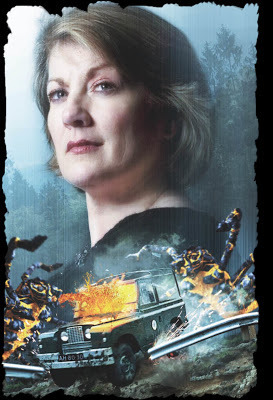 The persisting tension is heightened by the bravura performances of the cast, which not only features the already-mentioned Macqueen making a convincing bid for a role as a future Bond villain – “Hello you!”; but also a fresh-from-Middle-Earth Sylvester McCoy, who’s at the height of his pensive powers here; and a number of double and triple-headers that give the illusion of a cast of thousands. Cover artist Alex Mallinson warrants particular mention for his innumerable marginal roles, which at their extremes encompass a rampaging gigantic insect creature and an ill-fated UNIT private. The real star though is Tracey Childs, who gives her finest performance to date as Dr Elizabeth Klein. Childs was the perfect villain when she appeared all those years ago in Steve Lyons’ Colditz, but when she returned as an unlikely companion in the monthly range’s first trilogy of 2009, she added new layers to the character, complementing the intelligence and resolve of Colditzwith something more vulnerable, and, occasionally, sympathetic. UNIT: Dominion represents the apotheosis of the character as she seems to have become, even when she learns of what she was in another world, the best possible version of herself, true to the qualities that made her such a formidable fascist, but without any of the necessary evil. I’ve yet to listen to her recent return in Persuasion, but the way that she’s going I smell another spin-off series coming - one that I’d definitely purchase.
The persisting tension is heightened by the bravura performances of the cast, which not only features the already-mentioned Macqueen making a convincing bid for a role as a future Bond villain – “Hello you!”; but also a fresh-from-Middle-Earth Sylvester McCoy, who’s at the height of his pensive powers here; and a number of double and triple-headers that give the illusion of a cast of thousands. Cover artist Alex Mallinson warrants particular mention for his innumerable marginal roles, which at their extremes encompass a rampaging gigantic insect creature and an ill-fated UNIT private. The real star though is Tracey Childs, who gives her finest performance to date as Dr Elizabeth Klein. Childs was the perfect villain when she appeared all those years ago in Steve Lyons’ Colditz, but when she returned as an unlikely companion in the monthly range’s first trilogy of 2009, she added new layers to the character, complementing the intelligence and resolve of Colditzwith something more vulnerable, and, occasionally, sympathetic. UNIT: Dominion represents the apotheosis of the character as she seems to have become, even when she learns of what she was in another world, the best possible version of herself, true to the qualities that made her such a formidable fascist, but without any of the necessary evil. I’ve yet to listen to her recent return in Persuasion, but the way that she’s going I smell another spin-off series coming - one that I’d definitely purchase.And Klein’s struggle to step out of her overwritten self’s long shadow is mirrored beautifully - explicitly so, at one point - in the relationship between Macqueen and McCoy’s characters, which cuts a lot deeper than the competitive bickering that we’ve come to expect when we see more than one iteration of the Doctor together. UNIT: Dominion might be an action-packed and unusually filmic Doctor Who adventure, but at its core it’s quite a clever, and ultimately very moving, examination of the old ‘nature versus nurture’ debate that stretches from Third-Reich Britain in a world that never was, all the way back to the distant annals of Gallifrey’s forbidden past.
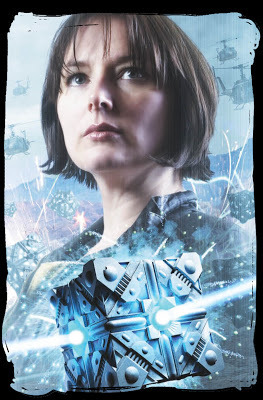 My only possible complaint about this production is that it’s billed as a Doctor Who / UNIT joint venture, but it doesn’t really bear any semblance to the original UNIT series that Big Finish rolled out almost a decade ago. I appreciate that Klein is a de facto part of UNIT now (in fact, she has the absent Lethbridge-Stewart’s last-held post in the UNIT series), but she’s nonetheless a character indelibly associated with Doctor Who, which is where we’d always found her prior to this masterpiece release, and beyond her the only UNIT faces on parade are new ones. This is actually beneficial though, in some ways, as by vesting our sympathies in the likes of genial Geordie grunt Pete Wilson (perfectly played by newcomer Bradley Gardner), Briggs and Arnopp draw us deeper into their story than they would’ve done had they filled it with more “posh totty”. Indeed, with his wife about to drop their first bairn, Sergeant Wilson (yes, it has to be a Dad’s Army gag) makes us care about every red-shirted soul that we encounter in their story irrespective of their rank - he’s like a 21st century Benton, albeit with the benefit of a back story. He conveniently fills Yates’s charm-the-companion boots too, offering Beth Chalmers’ Raine a much-needed foil in the lategoing. Other than her safe-cracking mind opening a few dimensional doors and an unexpected dose of future Doctor-fuelled insecurity, there are long stretches of narrative here that only posh-girl flirting will carry Raine through. Fortunately she excels at it.
My only possible complaint about this production is that it’s billed as a Doctor Who / UNIT joint venture, but it doesn’t really bear any semblance to the original UNIT series that Big Finish rolled out almost a decade ago. I appreciate that Klein is a de facto part of UNIT now (in fact, she has the absent Lethbridge-Stewart’s last-held post in the UNIT series), but she’s nonetheless a character indelibly associated with Doctor Who, which is where we’d always found her prior to this masterpiece release, and beyond her the only UNIT faces on parade are new ones. This is actually beneficial though, in some ways, as by vesting our sympathies in the likes of genial Geordie grunt Pete Wilson (perfectly played by newcomer Bradley Gardner), Briggs and Arnopp draw us deeper into their story than they would’ve done had they filled it with more “posh totty”. Indeed, with his wife about to drop their first bairn, Sergeant Wilson (yes, it has to be a Dad’s Army gag) makes us care about every red-shirted soul that we encounter in their story irrespective of their rank - he’s like a 21st century Benton, albeit with the benefit of a back story. He conveniently fills Yates’s charm-the-companion boots too, offering Beth Chalmers’ Raine a much-needed foil in the lategoing. Other than her safe-cracking mind opening a few dimensional doors and an unexpected dose of future Doctor-fuelled insecurity, there are long stretches of narrative here that only posh-girl flirting will carry Raine through. Fortunately she excels at it.For a closing thought, I must return to my opening movie analogy. If you’re wondering what UNIT: Dominion can offer you that your already-paid-for monthly range subscription doesn’t, it offers greater scale. It offers higher stakes. As absurd as it may sound in relation to an audio drama, it offers more action; bigger and bolder set pieces; 2.35:1 widescreen pictures. Even the closing theme that pre-empts the inevitable David Darlington sign-off sounds like it should be bound to a never-ending scroll of credits. But there is one key area where my simile is strained; one thing that will make UNIT: Dominion even more appealing to Big Finish’s target market than a truly authentic blockbuster movie-style audio drama. For all its bangs and flashes, UNIT: Dominion hasn’t been written for mass appeal, but for niche delight. Every layer that’s pulled back will slake some pent-up fanboy thirst somewhere, and every masterful twist of fate will have someone punching the air. The term ‘special’ tends to get thrown around a lot these days, but this luxury release has well and truly earned it.
UNIT: Dominion is available to download from Big Finish for £35.00. The CD box set version (which also comes with a free download) is just five pounds extra. You can read my 2011 review of Big Finish’s original UNIT spin-off series here.

The Doctor is looking for hope. But instead, he finds himself on a mission. The Time Lords have uncovered terrifying fragments of an insane plot to destroy the universe. And somehow, at the centre of that plot is one, random female in Earth’s history, Molly O’Sullivan.
Soon, the Doctor and Molly find themselves thrown headlong into a series of dangerous and terrifying adventures, with the dreaded Daleks never far behind them.
Read retro Doctor Who reviews @

Published on August 13, 2013 04:36
DVD Review | Doctor Who: The Reign of Terror
Published on August 13, 2013 03:28
August 3, 2013
Star Wars LEGO Review | 9499 Gungan Sub
I’d be very interested to see how well Star Wars: Episode I LEGO sets sell compared to those inspired by the other Star Wars movies and television series. Whilst most adult fans of LEGO probably have little interest in them, those that make up The Phantom Menace’s target demographic fall within this set’s 8 to 14 age range, or are possibly even younger. And it has to be said, for all its widely-accepted cinematic shortcomings, the Star Wars saga’s first chronological instalment certainly offers rich pickings when it comes to colourful inspirations for merchandising.

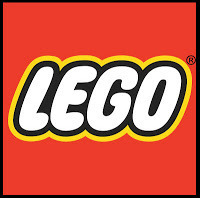 From my star destroyer-grey grown-up point of view, though, I’ve little interest in the vehicles of Episode I. The latest rendition of Darth Maul’s Sith Interceptor set was a mandatory purchase for me largely due to the exclusive minifigures that it offered, and much the same could be said of this Gungan Sub set. Be it by accident or design, until very recently Padmé was incredibly hard to find in LEGO form, having appeared only with an outmoded yellow skin tone many years ago, and until this set hit the shelves last year, she’d never been issued at all in her decadent Queen Amidala guise. The flesh-tone Qui-Gon Jinn is a little easier to find these days, thanks to his 2012 Sith Interceptor reissue, bus his flesh-tone, flame-haired apprentice had only been put out once previously, and even then in a time-limited and expensive set. And in this set, both Jedi find themselves with reversible heads, allowing the LEGO builder to either fix them with their default sober expressions, or flip their headpieces around and show them wearing the underwater breathing apparatus that they briefly utilised on screen.
From my star destroyer-grey grown-up point of view, though, I’ve little interest in the vehicles of Episode I. The latest rendition of Darth Maul’s Sith Interceptor set was a mandatory purchase for me largely due to the exclusive minifigures that it offered, and much the same could be said of this Gungan Sub set. Be it by accident or design, until very recently Padmé was incredibly hard to find in LEGO form, having appeared only with an outmoded yellow skin tone many years ago, and until this set hit the shelves last year, she’d never been issued at all in her decadent Queen Amidala guise. The flesh-tone Qui-Gon Jinn is a little easier to find these days, thanks to his 2012 Sith Interceptor reissue, bus his flesh-tone, flame-haired apprentice had only been put out once previously, and even then in a time-limited and expensive set. And in this set, both Jedi find themselves with reversible heads, allowing the LEGO builder to either fix them with their default sober expressions, or flip their headpieces around and show them wearing the underwater breathing apparatus that they briefly utilised on screen.

Even so, I couldn’t have justified the better part of £60.00 for just for a few minifigures, but when I stumbled across this set for only a little more than a third of its RRP languishing in a Smyths bargain bin, I couldn’t resist throwing it into the trolley where it sat incongruously amongst a throng of three-quid-a-pop Peppa Pig DVDs and a couple of frighteningly-realistic baby dolls (I have a little girl who couldn’t care less about Star Wars, but is at least warming to LEGO). And, by and large, I wasn’t disappointed with my punt.
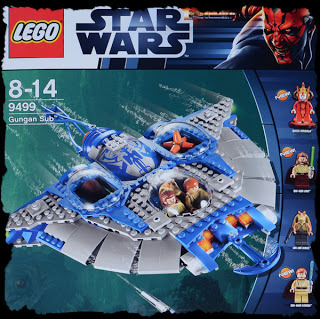 The highlight of the set is clearly Amidala, with whom LEGO have really pushed the boat out. Both her crown and ‘legs’ (for legs read ‘bell-bottomed base’) are unique pieces, so far as I can tell, and even her distinctive lead-white face with its I’m-out-of-my-depth look of puzzlement does look rather like Kiera Knightly’s beleaguered decoy, if not Natalie Portman’s democratically-elected monarch. The two Jedi are much more ordinary by comparison, kitted out in their usual sand ascetic robes, but that is exactly what’s called for. Save for his optional breathing apparatus, Qui-Gon appears exactly as he did alongside Darth Maul and company, with both his faux-cloak cape and astoundingly accurate hairpiece present and correct. Unfortunately the Obi-Wan figure suffers from its lazy use of the standard male LEGO hairpiece, which is nothing like the nearly-mullet that Ewan McGregor was forced to suffer on screen, but the Padawan braid is at least evident on the front of his tunic, offering at least the illusion of authenticity. For those that don’t already own him, the bespoke-moulded but ten-a-penny Jar Jar is an added bonus – even those who see him as the embodiment of everything that they feel went wrong with the Star Wars prequels can relish the prospect of beheading him time and again with their choice of green or blue lightsaber.
The highlight of the set is clearly Amidala, with whom LEGO have really pushed the boat out. Both her crown and ‘legs’ (for legs read ‘bell-bottomed base’) are unique pieces, so far as I can tell, and even her distinctive lead-white face with its I’m-out-of-my-depth look of puzzlement does look rather like Kiera Knightly’s beleaguered decoy, if not Natalie Portman’s democratically-elected monarch. The two Jedi are much more ordinary by comparison, kitted out in their usual sand ascetic robes, but that is exactly what’s called for. Save for his optional breathing apparatus, Qui-Gon appears exactly as he did alongside Darth Maul and company, with both his faux-cloak cape and astoundingly accurate hairpiece present and correct. Unfortunately the Obi-Wan figure suffers from its lazy use of the standard male LEGO hairpiece, which is nothing like the nearly-mullet that Ewan McGregor was forced to suffer on screen, but the Padawan braid is at least evident on the front of his tunic, offering at least the illusion of authenticity. For those that don’t already own him, the bespoke-moulded but ten-a-penny Jar Jar is an added bonus – even those who see him as the embodiment of everything that they feel went wrong with the Star Wars prequels can relish the prospect of beheading him time and again with their choice of green or blue lightsaber.

The 466-piece model is not without its charm either. Comprising just about the Gungans’ only contribution to the LEGO Star Wars universe, the 43cm-long submarine immediately stands out as something different from the many saga-spanning space vehicles and buildings in my mushrooming collection, adorned as it is with a distinctive rotating-tail propeller and mission statement of an anchor. The designers have added a lot of functionality too that goes beyond the usual flick missile and opening cockpits, the most notable of which is a detachable mini-sub at the ship’s rear in which you can despatch Jar Jar to one of his many, but sadly non-canonical, deaths. All the set is missing really is a beastly megafigure or two to menace our underwater heroes as they make their journey through Naboo’s watery core to Theed, but for £25.00 I can’t really complain. ’twas money well spent.
The Star Wars LEGO Gungan Sub is available from LEGO directly for £54.99 with free delivery. Today's cheapest online retailer though is John Lewis, who are currently selling this set for £43.97 with free delivery.

 From my star destroyer-grey grown-up point of view, though, I’ve little interest in the vehicles of Episode I. The latest rendition of Darth Maul’s Sith Interceptor set was a mandatory purchase for me largely due to the exclusive minifigures that it offered, and much the same could be said of this Gungan Sub set. Be it by accident or design, until very recently Padmé was incredibly hard to find in LEGO form, having appeared only with an outmoded yellow skin tone many years ago, and until this set hit the shelves last year, she’d never been issued at all in her decadent Queen Amidala guise. The flesh-tone Qui-Gon Jinn is a little easier to find these days, thanks to his 2012 Sith Interceptor reissue, bus his flesh-tone, flame-haired apprentice had only been put out once previously, and even then in a time-limited and expensive set. And in this set, both Jedi find themselves with reversible heads, allowing the LEGO builder to either fix them with their default sober expressions, or flip their headpieces around and show them wearing the underwater breathing apparatus that they briefly utilised on screen.
From my star destroyer-grey grown-up point of view, though, I’ve little interest in the vehicles of Episode I. The latest rendition of Darth Maul’s Sith Interceptor set was a mandatory purchase for me largely due to the exclusive minifigures that it offered, and much the same could be said of this Gungan Sub set. Be it by accident or design, until very recently Padmé was incredibly hard to find in LEGO form, having appeared only with an outmoded yellow skin tone many years ago, and until this set hit the shelves last year, she’d never been issued at all in her decadent Queen Amidala guise. The flesh-tone Qui-Gon Jinn is a little easier to find these days, thanks to his 2012 Sith Interceptor reissue, bus his flesh-tone, flame-haired apprentice had only been put out once previously, and even then in a time-limited and expensive set. And in this set, both Jedi find themselves with reversible heads, allowing the LEGO builder to either fix them with their default sober expressions, or flip their headpieces around and show them wearing the underwater breathing apparatus that they briefly utilised on screen.

Even so, I couldn’t have justified the better part of £60.00 for just for a few minifigures, but when I stumbled across this set for only a little more than a third of its RRP languishing in a Smyths bargain bin, I couldn’t resist throwing it into the trolley where it sat incongruously amongst a throng of three-quid-a-pop Peppa Pig DVDs and a couple of frighteningly-realistic baby dolls (I have a little girl who couldn’t care less about Star Wars, but is at least warming to LEGO). And, by and large, I wasn’t disappointed with my punt.
 The highlight of the set is clearly Amidala, with whom LEGO have really pushed the boat out. Both her crown and ‘legs’ (for legs read ‘bell-bottomed base’) are unique pieces, so far as I can tell, and even her distinctive lead-white face with its I’m-out-of-my-depth look of puzzlement does look rather like Kiera Knightly’s beleaguered decoy, if not Natalie Portman’s democratically-elected monarch. The two Jedi are much more ordinary by comparison, kitted out in their usual sand ascetic robes, but that is exactly what’s called for. Save for his optional breathing apparatus, Qui-Gon appears exactly as he did alongside Darth Maul and company, with both his faux-cloak cape and astoundingly accurate hairpiece present and correct. Unfortunately the Obi-Wan figure suffers from its lazy use of the standard male LEGO hairpiece, which is nothing like the nearly-mullet that Ewan McGregor was forced to suffer on screen, but the Padawan braid is at least evident on the front of his tunic, offering at least the illusion of authenticity. For those that don’t already own him, the bespoke-moulded but ten-a-penny Jar Jar is an added bonus – even those who see him as the embodiment of everything that they feel went wrong with the Star Wars prequels can relish the prospect of beheading him time and again with their choice of green or blue lightsaber.
The highlight of the set is clearly Amidala, with whom LEGO have really pushed the boat out. Both her crown and ‘legs’ (for legs read ‘bell-bottomed base’) are unique pieces, so far as I can tell, and even her distinctive lead-white face with its I’m-out-of-my-depth look of puzzlement does look rather like Kiera Knightly’s beleaguered decoy, if not Natalie Portman’s democratically-elected monarch. The two Jedi are much more ordinary by comparison, kitted out in their usual sand ascetic robes, but that is exactly what’s called for. Save for his optional breathing apparatus, Qui-Gon appears exactly as he did alongside Darth Maul and company, with both his faux-cloak cape and astoundingly accurate hairpiece present and correct. Unfortunately the Obi-Wan figure suffers from its lazy use of the standard male LEGO hairpiece, which is nothing like the nearly-mullet that Ewan McGregor was forced to suffer on screen, but the Padawan braid is at least evident on the front of his tunic, offering at least the illusion of authenticity. For those that don’t already own him, the bespoke-moulded but ten-a-penny Jar Jar is an added bonus – even those who see him as the embodiment of everything that they feel went wrong with the Star Wars prequels can relish the prospect of beheading him time and again with their choice of green or blue lightsaber.

The 466-piece model is not without its charm either. Comprising just about the Gungans’ only contribution to the LEGO Star Wars universe, the 43cm-long submarine immediately stands out as something different from the many saga-spanning space vehicles and buildings in my mushrooming collection, adorned as it is with a distinctive rotating-tail propeller and mission statement of an anchor. The designers have added a lot of functionality too that goes beyond the usual flick missile and opening cockpits, the most notable of which is a detachable mini-sub at the ship’s rear in which you can despatch Jar Jar to one of his many, but sadly non-canonical, deaths. All the set is missing really is a beastly megafigure or two to menace our underwater heroes as they make their journey through Naboo’s watery core to Theed, but for £25.00 I can’t really complain. ’twas money well spent.
The Star Wars LEGO Gungan Sub is available from LEGO directly for £54.99 with free delivery. Today's cheapest online retailer though is John Lewis, who are currently selling this set for £43.97 with free delivery.
Published on August 03, 2013 05:38
July 25, 2013
Prose vs Pictures #2 | Chuck Palahniuk's Fight Club vs David Fincher's Fight Club
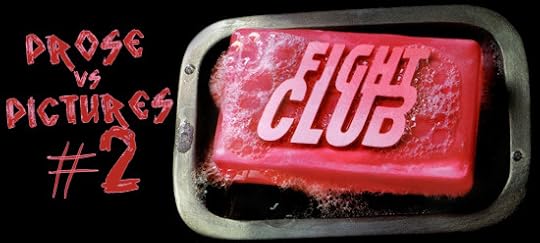
You’re here because someone broke the rules. Somebody told you about fight club, showed you Fight Club, or maybe even let you read Fight Club. So right now, you’re either thinking, “OK – the first rule of fight club is you don’t talk about fight club,” or, more likely, “There’s a book?”
I wish that I could lay claim to being of the twenty-seven people who’d heard of Fight Club before its movie adaptation became the most controversial box office hit of ’99, let alone one of the fourteen who’d actually read it, but, like most of the English-speaking world, my first experience of Chuck Palahniuk’s apostolic tale of “Tyler the great, who was perfect for one moment” was on the silver screen, where Seven director David Fincher used acting talent the calibre of Brad Pitt; Edward Norton; Helena Bonham Carter; and even a 90lb-moobs-sporting Meat Loaf to disprove the book’s assertion that “a moment is the most you could ever expect from perfection”. According to my Blu-ray player, Fincher successfully stretched out that fragile instant to one hour thirty-nine. It wasn’t until a few years after I’d worn out my Fight Club VHS, though, that I stumbled across a tie-in reissue of Palahniuk’s paperback, and found myself uttering that widespread, befuddled utterance: “There’s a book?”
Well tonight I’m not only gonna break fight club’s first and second rules and talk about Fight Club, I’m gonna go one better and make both of its iterations slog it out in the basement to find out, once and for all, which is the strongest.
 Fight Club was originally conceived as a written work. The story goes that Chuck was sitting bored at his desk at work, nursing a black eye that not one of his colleagues had dared to enquire about, when he decided to slack off work and try a little literary experiment. He tasked himself with crafting a seven-page piece that would somehow tell a complete story, but only through exploring its central conceits. He was looking for a new mode of storytelling; new “rules”, as he later described it. The story itself - the fight club, the fighting, even the underlying Jekyll and Hyde backbone - “was arbitrary”. Of course, his experiment turned out to be far more fruitful than he could ever have anticipated, as his completed Fight Clubstory was swiftly snapped up by a small anthology for just fifty bucks, and the novel that it blossomed into, of which that original story formed its sixth chapter, sold soon afterwards for only a little more. Fast-forward three more years, though, and Fox’s Fight Clubmovie had made fight club’s rules renowned worldwide – but sadly not Palahniuk’s. Yet it is these rules, this unique style, that makes Fight Club what it is in both its forms – it’s more monologue than movie or novel, and a tortuous one at that. The engineered, experimental style of storytelling that Palahniuk first played with on that torrid Tuesday follows the trains of thought of a nameless protagonist (whose on-screen aliases include Cornelius, Rupert and Travis) who’s seduced by the freedom offered to him by a man who sells soap for a living. And projects movies. And pees in soup. And is “full of useful information”, arcane knowledge and dazzling dogma that allows Palahniuk’s one-man narrative to leap from one defining moment to another. “Baggage handlers can ignore a ticking suitcase…” launches the reader into the tale of the narrator’s condo exploding; “To make soap, first we have to render fat…” prompts scenes of mutilation and homemade explosive manufacture, not to mention Robin Hood-like musings on the redistribution of surgically-removed excess body fat. It certainly beats the old he said / she said, particularly when almost every line is laced with a bizarre, diabolical doctrine that reads as being far more persuasive than it should be.
Fight Club was originally conceived as a written work. The story goes that Chuck was sitting bored at his desk at work, nursing a black eye that not one of his colleagues had dared to enquire about, when he decided to slack off work and try a little literary experiment. He tasked himself with crafting a seven-page piece that would somehow tell a complete story, but only through exploring its central conceits. He was looking for a new mode of storytelling; new “rules”, as he later described it. The story itself - the fight club, the fighting, even the underlying Jekyll and Hyde backbone - “was arbitrary”. Of course, his experiment turned out to be far more fruitful than he could ever have anticipated, as his completed Fight Clubstory was swiftly snapped up by a small anthology for just fifty bucks, and the novel that it blossomed into, of which that original story formed its sixth chapter, sold soon afterwards for only a little more. Fast-forward three more years, though, and Fox’s Fight Clubmovie had made fight club’s rules renowned worldwide – but sadly not Palahniuk’s. Yet it is these rules, this unique style, that makes Fight Club what it is in both its forms – it’s more monologue than movie or novel, and a tortuous one at that. The engineered, experimental style of storytelling that Palahniuk first played with on that torrid Tuesday follows the trains of thought of a nameless protagonist (whose on-screen aliases include Cornelius, Rupert and Travis) who’s seduced by the freedom offered to him by a man who sells soap for a living. And projects movies. And pees in soup. And is “full of useful information”, arcane knowledge and dazzling dogma that allows Palahniuk’s one-man narrative to leap from one defining moment to another. “Baggage handlers can ignore a ticking suitcase…” launches the reader into the tale of the narrator’s condo exploding; “To make soap, first we have to render fat…” prompts scenes of mutilation and homemade explosive manufacture, not to mention Robin Hood-like musings on the redistribution of surgically-removed excess body fat. It certainly beats the old he said / she said, particularly when almost every line is laced with a bizarre, diabolical doctrine that reads as being far more persuasive than it should be.
 Indeed, if you look at the book as written, there is a dearth of dialogue in the traditional sense – what the book presents are ideas and asides, often second-hand, woven into surprisingly eloquent and philosophical anecdotes. Since books became digitised, it’s become quite easy to gauge how impressed I am with a text – I simply look at how many highlights I’ve made in the iBooks app. With most top-tier novels, I generally highlight forty to fifty quotes or passages, but with Fight Club, which is a far shorter text than most (in print it would be 224 pages), I’ve made over three hundred. You’d end up looking more like the Brad Pitt of Snatch than the Brad Pitt of Fight Club if you were to tattoo even just the most memorable of Fight Club’s quotations onto your body. This makes for an extraordinary reading experience as the book has all the power and purpose of a clenched fist; not a word is wasted on exposition or plot-driving discourse. Instead, almost every word serves as an indictment of the ugly compromise and veiled slavery of modern life, where wants and needs are imposed by a brainwashing advertisement culture rather than being something intrinsic.
Indeed, if you look at the book as written, there is a dearth of dialogue in the traditional sense – what the book presents are ideas and asides, often second-hand, woven into surprisingly eloquent and philosophical anecdotes. Since books became digitised, it’s become quite easy to gauge how impressed I am with a text – I simply look at how many highlights I’ve made in the iBooks app. With most top-tier novels, I generally highlight forty to fifty quotes or passages, but with Fight Club, which is a far shorter text than most (in print it would be 224 pages), I’ve made over three hundred. You’d end up looking more like the Brad Pitt of Snatch than the Brad Pitt of Fight Club if you were to tattoo even just the most memorable of Fight Club’s quotations onto your body. This makes for an extraordinary reading experience as the book has all the power and purpose of a clenched fist; not a word is wasted on exposition or plot-driving discourse. Instead, almost every word serves as an indictment of the ugly compromise and veiled slavery of modern life, where wants and needs are imposed by a brainwashing advertisement culture rather than being something intrinsic. To his credit though, screenwriter Jim Uhls’ script seems to flow naturally from what’s written in the book, as it repurposes narration as dialogue and bridges the gaps in conversation with often equally-heavy, perfectly-attuned sentences that sound like pure Palahniuk. The “Cut the foreplay and just ask!” and “We’ve got the same briefcase” skits, and lines such as “How much can you know about yourself if you’ve never been in a fight?”; “Is that what a man looks like?”; “…a house full of condiments and no food…”; and especially Marla’s vitriolic “I have more of a right to be here [at a testicular cancer sufferers’ support group] than you – you still have your balls!” sit so well that the novel’s author must have been kicking himself when he saw the movie for the first time.

The film also handles Fight Club’s stylistics very well, using a blend of sharp cuts, rollercoaster prepositional segues, and other clever devices to maintain the book’s a-linear, sense-not-sequence presentation. Fincher even goes a step further in some instances, using his own inspired ideas to translate the feel of the book onto the screen, achieving the same end result through a totally different means. Just look at the apartment shots’ IKEA catalogue overlay, for instance; the mid-air collision fantasy; the Dust Brothers’ post-modern score; or even the amazing title sequence that begins inside the narrator’s brain and concludes with a pan straight through his skull.
Both incarnations of Fight Club share a sense of playfulness and mischief that belies the nihilistic terrors and truths that the story lays bare. Indeed, both on screen and in print, it possesses a slightly skewed, cartoonish quality that keeps it just outside the jaws of utter despair. Its ceaseless procession of soundbites that should leave you feeling like a Dalek on the receiving end of a Sylvester McCoy soliloquy are tempered by their muted, brown and green-graded “insomnia distance”. In print, even as Chloe writhes around in agony, her cancer eating away at her moribund body as the narrator counts down to her demise, “Prepare to evacuate soul in ten, in eight…”, you witness it through the cold apathy of a man who’s far more concerned with acquiring Swedish furniture and “near-life experiences” than he is the rueful fate of “post-consumer human butt wipe” who just wanted one last shag before slipping into the abyss.
 But there is one aspect of the novel that, by all rights, shouldn’t work on screen at all. It shouldn’t really even work in prose at all, but when the reader’s divorced from the visuals, it at least has a fighting chance. Now before you read any further, I should issue a spoiler warning in the form of a question. Do you know about Tyler Durden? For years, everywhere you go, everybody’s probably been asking you, “Do you know about Tyler Durden?” If you’ve seen the movie, I’m guessing that you do, but I figured that I should ask at this point, because it could ruin one of those Sixth Sense things if not. Well, kinda.
But there is one aspect of the novel that, by all rights, shouldn’t work on screen at all. It shouldn’t really even work in prose at all, but when the reader’s divorced from the visuals, it at least has a fighting chance. Now before you read any further, I should issue a spoiler warning in the form of a question. Do you know about Tyler Durden? For years, everywhere you go, everybody’s probably been asking you, “Do you know about Tyler Durden?” If you’ve seen the movie, I’m guessing that you do, but I figured that I should ask at this point, because it could ruin one of those Sixth Sense things if not. Well, kinda.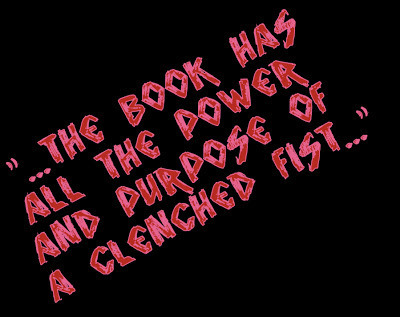 Part of the book’s genius is that, even though it’s obvious (or even if you already know, having come to the novel after watching the film, as I did), your mind erroneously infers things from the text almost involuntarily - it’s like one of those magic eye things. “I know this because Tyler knows this,” you read, your mind inventing the imparting of information from Tyler to Cornelius / Rupert / Travis. “Sometimes, Tyler speaks for me,” the book’s narrator says, and so your mind’s eye conjures Pitt standing in front of Norton, doing all the talking for him; not even the parroting depicted in the film’s hospital scene. “Tyler’s words coming out of my mouth” means exactly what it says; it’s the reader who presumes a verbal transference of dogma from one man to another; the reader who infers a disparity that’s not there. When the narrator dreams of humping Marla, who’s being nailed by the dynamic Mr Durden as he dozes, we think that they’re just dreams conjured by a sleeping mind processing her well-seen-to screams emanating from the room next-door. Even when the nameless protagonist throws a punch at Tyler and ends up connecting with the side of Tyler’s neck, you put it down to first-fight feebleness. Tyler’s euphoric “This is the greatest moment of our life” (my emphasis) is harder to get out of. Life? Singular? Shared. When it finally comes, “We both use the same body, but at different times… I am Tyler Durden,” tells readers nothing that hasn’t already crystallised by that point. It’s less of a twist, more of a gradual dawning. And so the problem that Fincher and Uhls faced when adapting the novel for cinema was that the audience had to see Tyler Durden right from his first appearance. Had he been presented as a more mischievous-looking Edward Norton, the Fight Club movie would have been a totally different – and, in my view, much tamer – animal. Instead, the movie embraces the conceit that Tyler Durden is a completely different and independent character to the man who narrates the tale, casting an (initially) lithe and chic version of Brad Pitt as the nocturnal id incarnate. This instantly gives the film not only a boost in terms of its mainstream appeal, but also its tone. Even as written, Fight Club is not the schizoid man writ large or a scientific study of dissociated personality disorders and psychogenic fugues. It’s closer to science fiction or fantasy in its cleanness; its high concept. The author even throws in a joke about the movie Sybil. One personality sleeps, the other comes to life. The first personality wakes up, the second recedes. It’s a ploy, a gimmick - a rule. And Fincher plays with it on screen every bit as much as Palahniuk does on the page, saturating his movie with visual cues as fleeting but decisive as one of Tyler’s cock-spliced family film reels, and even subtly altering lines and situations to raise an unreasonable doubt. “This is the greatest moment of your life…”
Part of the book’s genius is that, even though it’s obvious (or even if you already know, having come to the novel after watching the film, as I did), your mind erroneously infers things from the text almost involuntarily - it’s like one of those magic eye things. “I know this because Tyler knows this,” you read, your mind inventing the imparting of information from Tyler to Cornelius / Rupert / Travis. “Sometimes, Tyler speaks for me,” the book’s narrator says, and so your mind’s eye conjures Pitt standing in front of Norton, doing all the talking for him; not even the parroting depicted in the film’s hospital scene. “Tyler’s words coming out of my mouth” means exactly what it says; it’s the reader who presumes a verbal transference of dogma from one man to another; the reader who infers a disparity that’s not there. When the narrator dreams of humping Marla, who’s being nailed by the dynamic Mr Durden as he dozes, we think that they’re just dreams conjured by a sleeping mind processing her well-seen-to screams emanating from the room next-door. Even when the nameless protagonist throws a punch at Tyler and ends up connecting with the side of Tyler’s neck, you put it down to first-fight feebleness. Tyler’s euphoric “This is the greatest moment of our life” (my emphasis) is harder to get out of. Life? Singular? Shared. When it finally comes, “We both use the same body, but at different times… I am Tyler Durden,” tells readers nothing that hasn’t already crystallised by that point. It’s less of a twist, more of a gradual dawning. And so the problem that Fincher and Uhls faced when adapting the novel for cinema was that the audience had to see Tyler Durden right from his first appearance. Had he been presented as a more mischievous-looking Edward Norton, the Fight Club movie would have been a totally different – and, in my view, much tamer – animal. Instead, the movie embraces the conceit that Tyler Durden is a completely different and independent character to the man who narrates the tale, casting an (initially) lithe and chic version of Brad Pitt as the nocturnal id incarnate. This instantly gives the film not only a boost in terms of its mainstream appeal, but also its tone. Even as written, Fight Club is not the schizoid man writ large or a scientific study of dissociated personality disorders and psychogenic fugues. It’s closer to science fiction or fantasy in its cleanness; its high concept. The author even throws in a joke about the movie Sybil. One personality sleeps, the other comes to life. The first personality wakes up, the second recedes. It’s a ploy, a gimmick - a rule. And Fincher plays with it on screen every bit as much as Palahniuk does on the page, saturating his movie with visual cues as fleeting but decisive as one of Tyler’s cock-spliced family film reels, and even subtly altering lines and situations to raise an unreasonable doubt. “This is the greatest moment of your life…”
 Of course, it helps that Pitt and Norton are not only two of the finest actors of their generation, but were so committed to the Fight Club project that they each altered their bodies during filming to highlight Tyler’s growing dominance over whatshisname as the film progresses. Pitt hit the weights, piling on the muscle, and got a tan while Norton starved himself and wasted away. However, for every such gain, there’s a loss. On screen, the ‘relationship’ between these two aspects of spirit is far more complicated than it is in print, as Fincher’s film is underscored by a sense of homoeroticism that I didn’t get from the book. When the characters bathe together (which of course they would, if you think about it), the dialogue is played in such a way as to suggest a rejection of their heterosexuality, which clearly isn’t the case. Worse still, Pitt’s own revisions to the script move Tyler away from his original purpose and steer him towards something much grander, but disappointingly general in nature.
Of course, it helps that Pitt and Norton are not only two of the finest actors of their generation, but were so committed to the Fight Club project that they each altered their bodies during filming to highlight Tyler’s growing dominance over whatshisname as the film progresses. Pitt hit the weights, piling on the muscle, and got a tan while Norton starved himself and wasted away. However, for every such gain, there’s a loss. On screen, the ‘relationship’ between these two aspects of spirit is far more complicated than it is in print, as Fincher’s film is underscored by a sense of homoeroticism that I didn’t get from the book. When the characters bathe together (which of course they would, if you think about it), the dialogue is played in such a way as to suggest a rejection of their heterosexuality, which clearly isn’t the case. Worse still, Pitt’s own revisions to the script move Tyler away from his original purpose and steer him towards something much grander, but disappointingly general in nature. Indeed, the key difference between the written Fight Cluband its motion picture counterpart is why;why does the narrator’s Tyler Durden personality present when it does? There could a neurological reason, I suppose, but there’s little drama in that, and so thankfully neither version looks for one. The film instead paints a picture of man so desperate to escape the constraints of his humdrum, vacuous little existence that he creates an alter ego for himself who is the man that he wants to be – free, in every sense. But the novel goes beyond that, revealing that it was actually an external stimulus that caused its protagonist’s psyche to split clean two like a cartoon broken heart, and when it is revealed in the novel’s final furlong it casts everything from the story’s first parking lot brawl to Project Mayhem’s terrorism in a totally different light. Below this next picture is the real spoiler; the real Sixth Sensething.
 The force powerful enough to fracture our anonymous storyteller’s mind in two is love. Love that he, as himself, had no outlet for. His affections were wasted on lamps, chairs, rugs and dishes; the empty comforts of consumerism. And so he created a man who, to paraphrase the screenplay, looked like he wanted to look and fucked like he wanted to fuck. He created a personality that would appeal to a woman who pours her love into “the things that people love intensely and then dump an hour or a day after”; a woman whose glass slipper is a prophylactic sheath; a twisted, lump-breasted soul who fully appreciates that she could die at any moment, but whose tragedy is that she doesn’t. Tyler Durden was born to love Marla Singer, and everything else – the fight clubs, the Paper Street Soap Company, the space monkeys, Project Mayhem and all the other trappings of the liberating double life for which our hero isn’t culpable – is just an elaborate distraction from the amorous fear festering in our divided hero’s soul.
The force powerful enough to fracture our anonymous storyteller’s mind in two is love. Love that he, as himself, had no outlet for. His affections were wasted on lamps, chairs, rugs and dishes; the empty comforts of consumerism. And so he created a man who, to paraphrase the screenplay, looked like he wanted to look and fucked like he wanted to fuck. He created a personality that would appeal to a woman who pours her love into “the things that people love intensely and then dump an hour or a day after”; a woman whose glass slipper is a prophylactic sheath; a twisted, lump-breasted soul who fully appreciates that she could die at any moment, but whose tragedy is that she doesn’t. Tyler Durden was born to love Marla Singer, and everything else – the fight clubs, the Paper Street Soap Company, the space monkeys, Project Mayhem and all the other trappings of the liberating double life for which our hero isn’t culpable – is just an elaborate distraction from the amorous fear festering in our divided hero’s soul. Almost by extension, the film omits the novel’s final chapter and epilogue, which whilst not as fundamental a departure as Tyler’s raison d’être, further skews one’s perception of our narrator’s world. The movie is pretty emphatic in its portrayal of Tyler’s defeat and the surviving Marla and thingy’s almost-by-default instant Hollywood love, but in print Palahniuk leaves us with more than a reasonable doubt as to our heroes’ fates, as the afterlife described – with its white walls, regular meds and, apparently, decent postal service – sounds suspiciously clinical in nature to me. The Pixies ask “Where is My Mind?” as the buildings fall in the film, but it’s only in the book that the question still burns afterwards.
 It’s 2-0 to prose, I’m afraid, moviegoers.
It’s 2-0 to prose, I’m afraid, moviegoers. Fincher’s Fight Club is the ultimate dick flick, a masterpiece that ranks amongst my favourite films, but despite its fairly faithful preservation of the book’s meandering monologues and train-of-thought storyline, it lacks the superlatively-twisted romance and unyielding, hole-in-the-cheek bleakness of the novel. In both versions, Tyler Durden and Project Mayhem represent the freedom and anarchy that the weary narrator so craves, but the book goes much further than the film in highlighting the pleasures and pitfalls of that freedom - it’s a question of emphasis and extent; the difference between threatening to cut off someone’s cojones and actually doing it. On the page, the castrating effect of society is fought on a ‘fire with fire’ basis, Project Mayhem’s scare tactics in the film having their roots in the actually-severed testicles bagged and tagged in Tyler Durden’s literary freezer, and Palahniuk returns to the incredibly powerful metaphor of the puppy pound time and again, “Where even if someone loves you enough to save your life, they still castrate you.” Such sentiments encapsulate it all.
 On a final note, you know a book is really something special when even its afterword contains phrases as potent as “Margaret Thatcher has eaten my cum.” If you’ve only seen the film, what you’re feeling is premature enlightenment.
On a final note, you know a book is really something special when even its afterword contains phrases as potent as “Margaret Thatcher has eaten my cum.” If you’ve only seen the film, what you’re feeling is premature enlightenment. Chuck Palahniuk's Fight Club novel is currently available in paperback (best price online today: £3.00 at Books etc) and digital formats (£3.79 from Amazon's Kindle Store or £3.99 from iTunes). Yesterday, the news broke that Palahniuk is working on a graphic novel sequel. David Fincher's Fight Club movie is available from iTunes in 1080p HD for just £8.99, albeit without any extras. If you’re after bonus material too, a 10th Anniversary Blu-ray is available (best price online today: £7.00 on Amazon ).
Published on July 25, 2013 05:06
July 21, 2013
Blu-ray Review | Doctor Who: Spearhead from Space
Published on July 21, 2013 06:34
E.G. Wolverson's Blog
- E.G. Wolverson's profile
- 52 followers
E.G. Wolverson isn't a Goodreads Author
(yet),
but they
do have a blog,
so here are some recent posts imported from
their feed.


